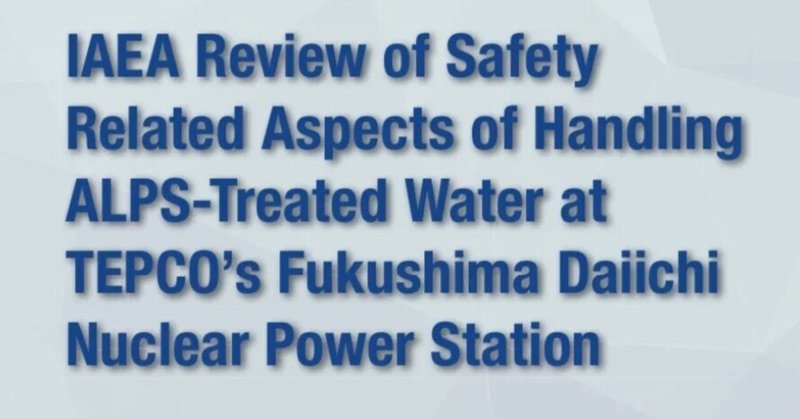
【資料】ALPS処理水の海洋放出 「IAEA独自検査」
[2023/9/9更新]
IAEAの独自検査とは、東電から提供されたサンプルを、IAEAの第三者分析機関と日本の分析機関のそれぞれの結果を相互比較して、同一であることを確認し、東電のデータの信憑性を裏付け、日本の分析機関が国際基準に照らして高い正確性と能力を有していると評価したもの。
すなわち、安全性の監査というよりは
検査方法と能力の技術的な監査である
[序文]
ここに記載された見解は、必ずしもIAEA加盟国の見解を反映するものではない。
IAEAおよびその加盟国は、本報告書の使用から生じる結果についていかなる責任も負わない。
[EXECUTIVE SUMMARY]
本ILCの主な調査結果は以下の通りである:
- 東京電力の測定精度の高さと技術力の高さ。
- 東京電力の試料採取手順は、代表的な試料を得るために必要な適切な方法論的基準に従っている。
- 異なる放射性核種について東京電力が利用した選択された分析方法は適切であり、目的に適合していた。
- IAEAも、参加した第三者検査機関も、追加的な放射性核種(すなわち、線源用語に含まれる以上の放射性核種)を有意なレベルで検出しなかった。
[P10 COLLECTION AND PREPARATION OF ALPS TREATED WATER SAMPLES]
本ILC用サンプルは、2022年3月24日にFDNPS のK4-B ALPS施設から、IAEAスタッフの立会いの下、採取された。
[P32 7.CONCLUSION]
このILCは、ALPS処理水の排出に関して東京電力が実施したソースモニタリングの信憑性を確認するために実施された。
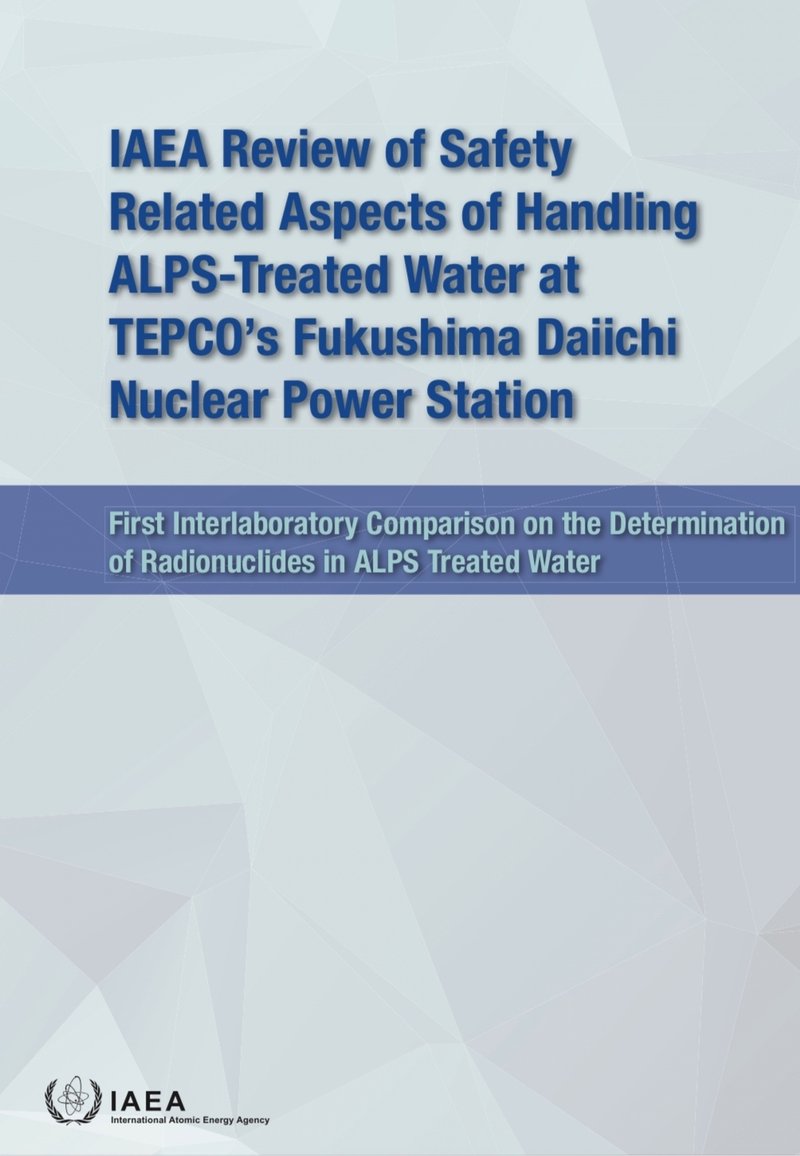
東京電力福島第一原子力発電所におけるALPS処理水の安全性に関するIAEAレビュー
ALPS処理水に含まれる放射性核種の定量に関する初の試験所間比較
https://www.iaea.org/sites/default/files/first_interlaboratory_comparison_on_the_determination_of_radionuclides_in_alps_treated_water.pdf

This is a report by the IAEA on progress of the IAEA Review of Safety Related Aspects of Handling ALPS-Treated Water at TEPCO’s Fukushima Daiichi Nuclear Power Station. The views expressed herein do not necessarily reflect those of IAEA Member States. Although great care has been taken to maintain the accuracy of information contained in this report, neither the IAEA nor its Member States assume any responsibility for consequences which may arise from its use. The use of particular designations of countries or territories does not imply any judgement by the IAEA, as to the legal status of such countries or territories, of their authorities and institutions or of the delimitation of their boundaries. The mention of names of specific companies or products (whether or not indicated as registered) does not imply any intention to infringe proprietary rights, nor should it be construed as an endorsement or recommendation on the part of the IAEA. The IAEA assumes no responsibility for the accuracy or continuing existence of URLs for external or third party internet web sites referred to in this report and does not guarantee that any content on such web sites is, or will remain, accurate or appropriate.
本報告書は、東京電力福島第一原子力発電所におけるALPS処理水の取扱いに関する安全関連側面に関するIAEAレビューの進捗状況に関するIAEAによる報告書である。ここに記載された見解は、必ずしもIAEA加盟国の見解を反映するものではない。本報告書に含まれる情報の正確性を維持するために細心の注意を払っているが、IAEAおよびその加盟国は、本報告書の使用から生じる結果についていかなる責任も負わない。特定の国や地域の名称の使用は、そのような国や地域の法的地位、当局や機関、境界の画定についてIAEAが判断することを意味するものではない。特定の企業名や製品名(登録済みであるか否かを問わず)の記載は、所有権を侵害する意図を意味するものではなく、IAEAの支持や推奨と解釈されるべきものでもない。IAEAは、本レポートで言及されている外部または第三者のインターネットウェブサイトのURLの正確性または継続的な存在について一切の責任を負わず、そのようなウェブサイト上のいかなるコンテンツも正確または適切であること、または将来にわたって正確または適切であり続けることを保証しない。
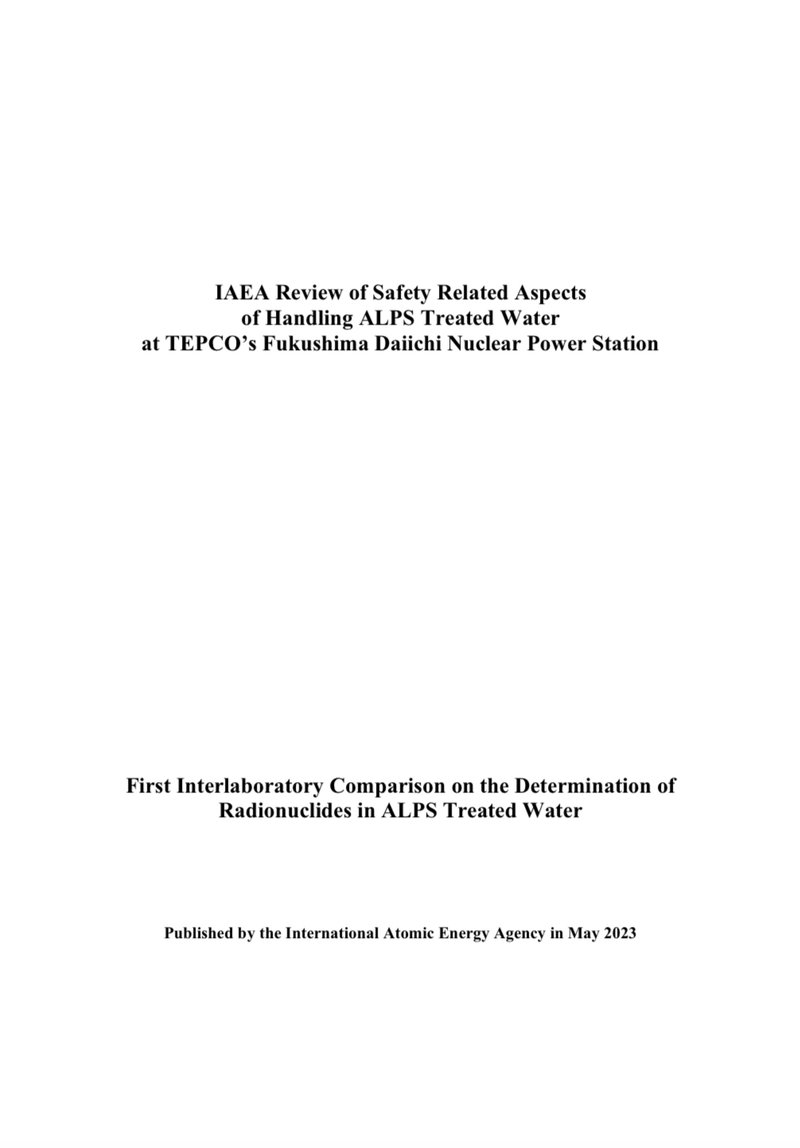

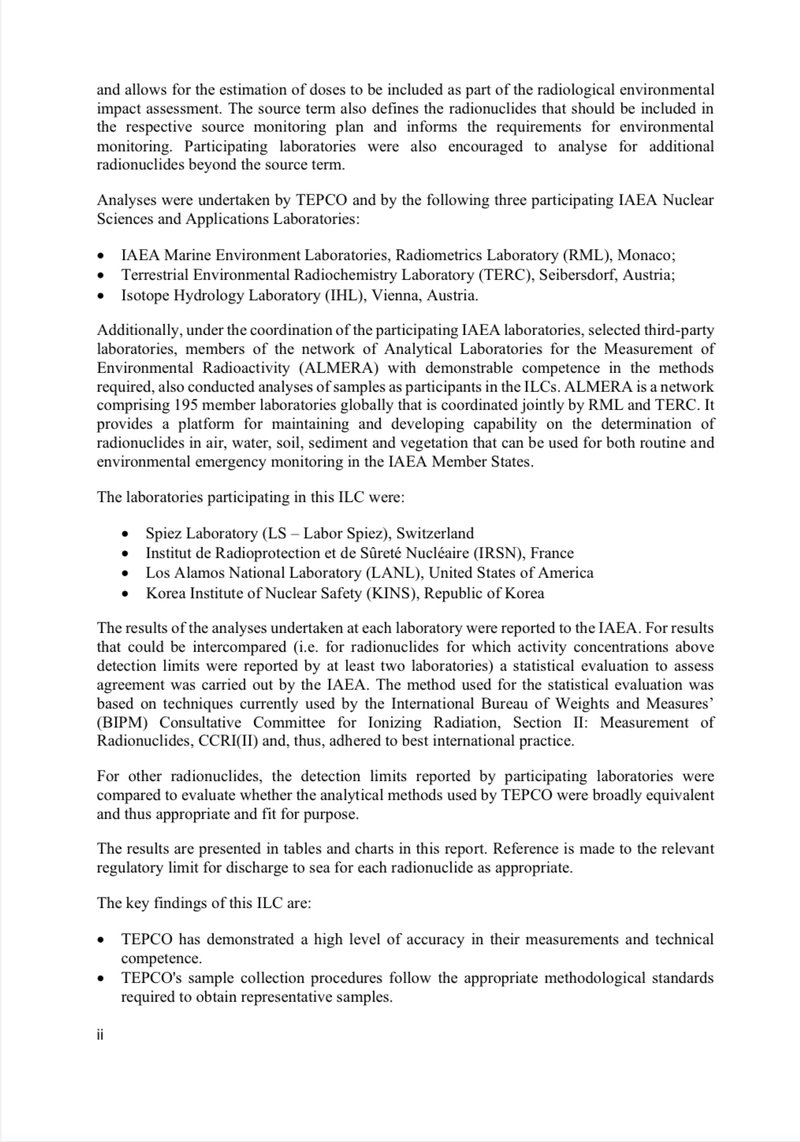

EXECUTIVE SUMMARY
In 2021, the IAEA started its review of safety related aspects of handling ALPS (Advanced Liquid Processing System) treated water at TEPCO’s Fukushima Daiichi Nuclear Power Station (FDNPS). Consistent with the request from the Government of Japan, the IAEA statutory functions and the mandate of the Task Force, the scope of the IAEA review is tailored to assessing safety related aspects of the implementation of Japan’s Basic Policy on Handling of ALPS Treated Water at the Tokyo Electric Power Company’s Holdings’ Fukushima Daiichi Nuclear Power Station against the IAEA international safety standards. The current approach outlined in the Basic Policy is to conduct a series of controlled discharges of ALPS treated water into the sea (‘batch discharges’) over a period of approximately 30 years.
Consistent with relevant IAEA international safety standards, TEPCO is required to determine the characteristics and activity of the ALPS treated water (e.g., through the radiological environmental impact assessment) to be discharged into the sea, and to establish and implement monitoring programmes to ensure that public exposure due to the discharges is adequately assessed and that the assessment is sufficient to verify and demonstrate compliance with the authorization granted by the NRA.
To conduct its safety review, the IAEA has organized the work of the Task Force into three main components, the assessment of protection and safety; regulatory activities and processes; and independent sampling, data corroboration, and analysis. Further, the IAEA’s independent sampling, data corroboration, and analysis activities include three elements:
• Sampling, analysis and interlaboratory comparison for ALPS treated water from the FDNPS.
• Sampling, analysis and interlaboratory comparison for environmental samples (e.g., seawater, fish) from the surrounding environment of FDNPS.
• Assessment of the capabilities of dosimetry service providers involved in the monitoring of internal and external radiation exposure of workers at FDNPS.
The IAEA’s sampling, data corroboration, and analysis activities also include a review of sampling and analytical methods used by TEPCO and any other relevant technical institutions.
The corroboration of source and environmental monitoring conducted by TEPCO and other Japanese ministries and organizations is based on interlaboratory comparisons (ILCs). ILCs, along with proficiency tests (PTs), are standard methods for laboratories to assess the quality of their measurement results in comparison with those of other participating laboratories, and to identify any potential improvements. PTs involve the evaluation of performance against pre- established criteria whereas ILCs involve the organization, performance, and evaluation of measurements on the same or similar items by two or more laboratories in accordance with predetermined conditions.
For this first ILC under the IAEA’s ALPS safety review, the ALPS treated water samples were taken in March 2022 from the K4-B tank group at FDNPS. The water contained in the K4-B tank group is expected to be the first batch of ALPS treated water that will be discharged, only once TEPCO receives all regulatory approvals from NRA. The focus of the analysis efforts for this ILC were on the radionuclides from the source term (Table 3) which are included in the radiological environmental impact assessment conducted by TEPCO. A source term refers to the amount and isotopic composition of radioactive material that is released, in this case as part of a controlled discharge. It is used for modelling releases of radionuclides into the environment and allows for the estimation of doses to be included as part of the radiological environmental impact assessment. The source term also defines the radionuclides that should be included in the respective source monitoring plan and informs the requirements for environmental monitoring. Participating laboratories were also encouraged to analyse for additional radionuclides beyond the source term.
Analyses were undertaken by TEPCO and by the following three participating IAEA Nuclear Sciences and Applications Laboratories:
• IAEA Marine Environment Laboratories, Radiometrics Laboratory (RML), Monaco;
• Terrestrial Environmental Radiochemistry Laboratory (TERC), Seibersdorf, Austria;
• Isotope Hydrology Laboratory (IHL), Vienna, Austria.
Additionally, under the coordination of the participating IAEA laboratories, selected third-party laboratories, members of the network of Analytical Laboratories for the Measurement of Environmental Radioactivity (ALMERA) with demonstrable competence in the methods required, also conducted analyses of samples as participants in the ILCs. ALMERA is a network comprising 195 member laboratories globally that is coordinated jointly by RML and TERC. It provides a platform for maintaining and developing capability on the determination of radionuclides in air, water, soil, sediment and vegetation that can be used for both routine and environmental emergency monitoring in the IAEA Member States.
The laboratories participating in this ILC were:
• Spiez Laboratory (LS – Labor Spiez), Switzerland
• Institut de Radioprotection et de Sûreté Nucléaire (IRSN), France
• Los Alamos National Laboratory (LANL), United States of America
• Korea Institute of Nuclear Safety (KINS), Republic of Korea
The results of the analyses undertaken at each laboratory were reported to the IAEA. For results that could be intercompared (i.e. for radionuclides for which activity concentrations above detection limits were reported by at least two laboratories) a statistical evaluation to assess agreement was carried out by the IAEA. The method used for the statistical evaluation was based on techniques currently used by the International Bureau of Weights and Measures’ (BIPM) Consultative Committee for Ionizing Radiation, Section II: Measurement of Radionuclides, CCRI(II) and, thus, adhered to best international practice.
For other radionuclides, the detection limits reported by participating laboratories were compared to evaluate whether the analytical methods used by TEPCO were broadly equivalent and thus appropriate and fit for purpose.
The results are presented in tables and charts in this report. Reference is made to the relevant regulatory limit for discharge to sea for each radionuclide as appropriate.
The key findings of this ILC are:
• TEPCO has demonstrated a high level of accuracy in their measurements and technical competence.
• TEPCO's sample collection procedures follow the appropriate methodological standards required to obtain representative samples.
• The selected analytical methods utilized by TEPCO for different radionuclides were appropriate and fit for purpose.
• Neither the IAEA, nor the participating third-party laboratories, detected any additional radionuclides (i.e., radionuclides beyond what is included in the source term) at significant levels.
The IAEA notes that these findings provide confidence in TEPCO’s capability for undertaking accurate and precise measurements related to the discharge of ALPS treated water. Furthermore, based on the observations of the IAEA, TEPCO has demonstrated that they have a sustainable and robust analytical system in place to support the ongoing technical needs at FDNPS during the discharge of ALPS treated water.
Additional ILCs will be conducted in the future for ALPS treated water, as well as environmental samples, and occupational radiation protection1. The results from the first ILC for environmental samples, which were taken in November 2022, will be available later in 2023; these first samples will serve as a baseline for future environmental monitoring. Future ILCs, conducted after water discharges start in 2023, will allow for an assessment of any changes in the levels of relevant radionuclides in the marine environment, relative to the baseline. Furthermore, the corroboration of environmental monitoring complements a separate project – NA3/38 Marine Monitoring: Confidence Building and Data Quality Assurance – addressing the quality of data from marine monitoring undertaken in Japan following the accident at FDNPS. Through project NA3/38, which has been implemented since 2014, the IAEA is assisting the Government of Japan in ensuring that sea area monitoring carried out under the regularly updated Comprehensive Radiation Monitoring Plan is comprehensive, credible and transparent and is helping to build confidence of the stakeholders in the accuracy and quality of the marine monitoring data. Within project NA3/38, the IAEA has organized a series of ILCs and PTs to test the sampling and analytical performance of the Japanese laboratories for the analysis of radionuclides in seawater, sediment, and fisheries samples. Data from this project are available online at:
The results from the first ILC for occupational radiation protection will be available later in 2023. This first ILC will focus on external dosimetry, whereas future ILCs for occupational radiation protection will focus on internal dosimetry. ILCs for occupational radiation protection will be conducted between the IAEA’s Radiation Safety Technical Services Laboratory and the individual monitoring service used by TEPCO for FDNPS workers.
要旨
2021年、IAEAは東京電力福島第一原子力発電所(FDNPS)におけるALPS(改良型液体処理システム)処理水の取り扱いに関する安全関連のレビューを開始した。日本政府からの要請、IAEAの法定機能、タスクフォースの任務に従い、IAEAのレビューの範囲は、東京電力ホールディングス福島第一原子力発電所におけるALPS処理水の取り扱いに関する日本の基本方針の実施について、IAEAの国際安全基準に照らして、安全関連の側面を評価することに調整されている。現在の基本方針では、ALPS処理水の海への放出(「一括放流」)を約30年間にわたって管理しながら実施することになっている。
関連するIAEAの国際安全基準に沿って、東京電力は、海洋に放出されるALPS処理水の特性および放射能を決定し(例えば、放射線環境影響評価を通じて)、放出による公衆被ばくが適切に評価され、その評価が規制委 員会から付与された認可の遵守を検証し実証するのに十分であることを保証するためのモニタリングプログラムを確立し、実施することが求められている。
安全審査を実施するために、IAEAはタスクフォースの作業を、防護と安全の評価、規制活動とプロセス、独立したサンプリング、データの裏付け、分析の3つの主要な構成要素に整理した。さらに、IAEAの独立サンプリング、データの裏付け、分析活動には3つの要素が含まれる:
- FDNPSからのALPS処理水のサンプリング、分析および試験所間比較。
- FDNPSの周辺環境から採取された環境試料(海水、魚類など)のサンプリング、分析、試験所間比較。
- FDNPSにおける作業員の内部被ばくおよび外部被ばくのモニタリングに関与する線量測定サービスプロバイダーの能力評価。
IAEAのサンプリング、データの裏付け、分析活動には、東京電力およびその他の関連技術機関が使用するサンプリングおよび分析方法のレビューも含まれる。
東京電力および日本の他の省庁・機関が実施する線源および環境モニタリングの裏付けは、試験所間比較(ILC)に基づいている。ILCは、技能試験(PT)とともに、試験所が他の参加試験所の測定結果と比較してその測定結果の質を評価し、改善の可能性を特定するための標準的な方法である。PTは事前に設定された基準に照らして性能を評価するものであるのに対し、ILCは事前に設定された条件に従って、2つ以上の試験所が同一または類似の項目について測定を組織、実施、評価するものである。
IAEAのALPS安全レビューに基づく今回の最初のILCでは、2022年3月にFDNPSのK4-Bタンク群からALPS処理水を採取した。K4-Bタンク群に含まれる水は、東京電力が規制当局からすべての規制認可を受けた後にのみ、排出されるALPS処理水の最初のバッチとなる予定である。本ILCの分析作業の焦点は、東京電力が実施した放射線環境影響評価に含まれるソースターム (表3)の放射性核種である。ソースタームとは、放出される放射性物質の量と同位体組成のことで、この場合は管理放出の一部として放出される。環境中への放射性核種の放出をモデル化するために使用され、放射線環境影響評価の一部として含まれる線量の推定を可能にする。線源用語はまた、それぞれの線源モニタリング計画に含めるべき放射性核種を定義し、環境モニタリングの要件を通知する。参加研究所は、線源項以外の放射性核種についても分析するよう奨励された。
分析は、東京電力と、参加した以下の3つのIAEA原子力科学・応用研究所によって行われた:
- IAEA海洋環境研究所、放射線測定研究所(RML)、モナコ;
- 陸域環境放射化学研究所(TERC)、ザイバースドルフ、オーストリア;
- 同位体水文学研究所(IHL)、ウィーン、オーストリア。
さらに、IAEA参加研究所の調整の下、環境放射能測定分析研究所ネットワーク(ALMERA)のメンバーであり、要求される分析法において実証可能な能力を有する第三者研究機関も、ILCの参加機関として試料の分析を実施した。ALMERAは、RMLとTERCが共同で調整する、世界195の加盟試験所からなるネットワークである。IAEA加盟国において、大気、水、土壌、堆積物、植生に含まれる放射性核種の測定能力を維持・開発するためのプラットフォームを提供し、日常的なモニタリングと環境緊急時のモニタリングの両方に利用できる。
このILCに参加した研究所は以下の通りである:
- スピース研究所(LS - Labor Spiez)、スイス
- 放射線防護・核安全研究所(IRSN)、フランス
- ロスアラモス国立研究所(LANL)、米国
- 韓国原子力安全研究院(KINS)、韓国
各研究所で実施された分析結果はIAEAに報告された。相互比較が可能な結果(すなわち、検出限界以上の放射能濃度が少なくとも2つの研究所から報告された放射性核種)については、IAEAによって一致度を評価するための統計的評価が実施された。統計的評価に用いられた手法は、国際度量衡局(BIPM)の電離放射線諮問委員会(Section II)放射性核種の測定、CCRI(II)で現在使用されている手法に基づいており、国際的なベストプラクティスに準拠している。
その他の放射性核種については、参加検査機関から報告された検出下限値を比較し、東京電力が使用した分析方法が広範に同等であり、したがって適切で目的に適合しているかどうかを評価した。
その結果は本報告書の表とグラフに示されている。各放射性核種に関連する海への排出規制値は適宜参照されたい。
本ILCの主な調査結果は以下の通りである:
- 東京電力の測定精度の高さと技術力の高さ。
- 東京電力の試料採取手順は、代表的な試料を得るために必要な適切な方法論的基準に従っている。
- 異なる放射性核種について東京電力が利用した選択された分析方法は適切であり、目的に適合していた。
- IAEAも、参加した第三者検査機関も、追加的な放射性核種(すなわち、線源用語に含まれる以上の放射性核種)を有意なレベルで検出しなかった。
IAEAは、これらの知見により、東京電力がALPS処理水の放流に関連する正確かつ精密な測定を実施する能力を有しているとの確信を得たと指摘する。さらに、IAEAの観察に基づき、東京電力は、FDNPSにおけるALPS処理水の排出中の継続的な技術的ニーズをサポートするための持続可能で強固な分析システムを有していることを実証した。
今後、ALPS処理水、環境試料、職業放射線防護1について、追加のILCが実施される予定である。2022年11月に採取された環境サンプルの最初のILCの結果は、2023年後半に得られる予定である。これらの最初のサンプルは、将来の環境モニタリングのベースラインとなる。2023年に放水が開始された後に実施される今後のILCでは、海洋環境中の関連放射性核種レベルのベースラインに対する変化を評価することができる。さらに、環境モニタリングの裏付けは、NA3/38海洋モニタリングという別のプロジェクトを補完するものである:FDNPSの事故後、日本で実施された海洋モニタリングのデータの質に取り組むものである。2014年から実施されているプロジェクトNA3/38を通じて、IAEAは、定期的に更新される包括的放射線モニタリング計画の下で実施される海域モニタリングが包括的で、信頼性が高く、透明性のあるものであることを確保するために日本政府を支援しており、海洋モニタリングデータの正確性と質に対する利害関係者の信頼構築を支援している。プロジェクトNA3/38の中で、IAEAは一連のILCとPTを組織し、海水、底質、漁業サンプル中の放射性核種の分析について、日本の研究所のサンプリングと分析性能をテストした。このプロジェクトのデータはオンラインで入手できる:
職業放射線防護のための最初のILCの結果は、2023年後半に利用可能になる予定である。この最初のILCは外部被ばく線量測定に焦点を当てるが、将来の職業放射線防護のためのILCは内部被ばく線量測定に焦点を当てる。職業放射線防護のためのILCは、IAEAの放射線安全技術サービス研究所と、東京電力がFDNPS作業員に対して利用している個人モニタリングサービスとの間で実施される。

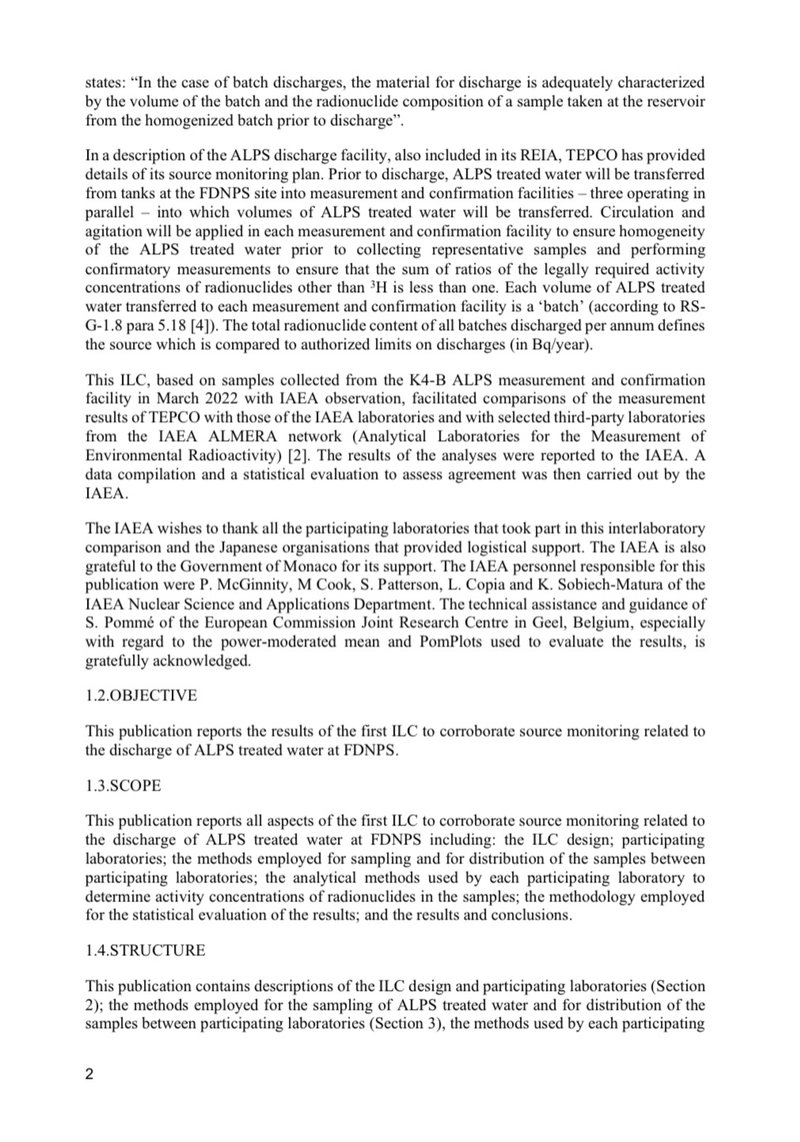
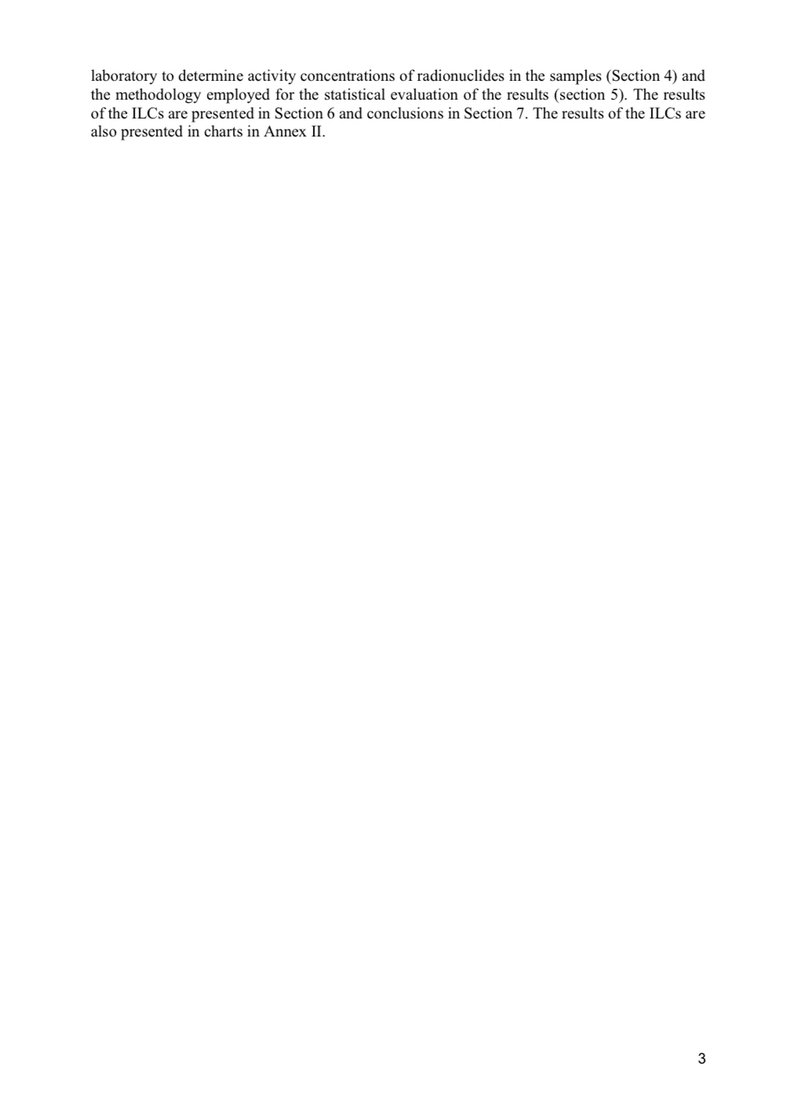
1.1.BACKGROUND
The corroboration of a representative subset of the radioactivity measurement results reported by TEPCO and relevant Japanese authorities during both the pre-operational and the operational phases of discharge of ALPS treated water to the sea, and a review of the methods for related sampling and analysis used by TEPCO and relevant Japanese authorities is being undertaken by the IAEA. This corroboration provides an independent check of the veracity of the radiological data resulting from source and environmental monitoring programmes related to the ALPS discharges upon which the safety related aspects of the discharges of ALPS treated water are being evaluated. The scope of the corroboration includes an independent check of the radiological characterization of the discharges. A primary objective is to promote transparency and provide sound information to enable interested parties to evaluate the radiological data used as the basis for planning the discharges of ALPS treated water into the sea.
The IAEA corroboration of source and environmental monitoring related to discharges of ALPS treated water from FDNPS is comprised of three distinct elements (see also Figure 1):
1. Review of sampling and analytical methods for source and environmental monitoring related to ALPS treated water at FDNPS used by TEPCO and relevant Japanese authorities.
2. Corroboration of source monitoring undertaken by TEPCO, including a comprehensive
radiological characterization of ALPS treated water samples.
3. Corroboration of environmental monitoring undertaken by TEPCO and relevant Japanese
authorities.
The corroboration of source and environmental monitoring is based on interlaboratory comparisons (ILCs). ILCs, along with proficiency tests (PTs), are standard methods for laboratories to assess the quality of their measurement results in comparison with those of other participating laboratories, and to identify any potential improvements. PTs involve the evaluation of performance against pre-established criteria whereas ILCs involve the organization, performance and evaluation of measurements on the same or similar items by two or more laboratories in accordance with predetermined conditions [1].
This publication reports the results of the first ILC to corroborate source monitoring.
According to its design stage radiological environmental impact assessment (REIA) [3], TEPCO has selected a “batch discharge” methodology. Safety Guide RS-G-1.8 para 5.18 [4] states: “In the case of batch discharges, the material for discharge is adequately characterized by the volume of the batch and the radionuclide composition of a sample taken at the reservoir from the homogenized batch prior to discharge”.
In a description of the ALPS discharge facility, also included in its REIA, TEPCO has provided details of its source monitoring plan. Prior to discharge, ALPS treated water will be transferred from tanks at the FDNPS site into measurement and confirmation facilities – three operating in parallel – into which volumes of ALPS treated water will be transferred. Circulation and agitation will be applied in each measurement and confirmation facility to ensure homogeneity of the ALPS treated water prior to collecting representative samples and performing confirmatory measurements to ensure that the sum of ratios of the legally required activity concentrations of radionuclides other than 3H is less than one. Each volume of ALPS treated water transferred to each measurement and confirmation facility is a ‘batch’ (according to RS- G-1.8 para 5.18 [4]). The total radionuclide content of all batches discharged per annum defines the source which is compared to authorized limits on discharges (in Bq/year).
This ILC, based on samples collected from the K4-B ALPS measurement and confirmation facility in March 2022 with IAEA observation, facilitated comparisons of the measurement results of TEPCO with those of the IAEA laboratories and with selected third-party laboratories from the IAEA ALMERA network (Analytical Laboratories for the Measurement of Environmental Radioactivity) [2]. The results of the analyses were reported to the IAEA. A data compilation and a statistical evaluation to assess agreement was then carried out by the IAEA.
The IAEA wishes to thank all the participating laboratories that took part in this interlaboratory comparison and the Japanese organisations that provided logistical support. The IAEA is also grateful to the Government of Monaco for its support. The IAEA personnel responsible for this publication were P. McGinnity, M Cook, S. Patterson, L. Copia and K. Sobiech-Matura of the IAEA Nuclear Science and Applications Department. The technical assistance and guidance of S. Pommé of the European Commission Joint Research Centre in Geel, Belgium, especially with regard to the power-moderated mean and PomPlots used to evaluate the results, is gratefully acknowledged.
1.2.OBJECTIVE
This publication reports the results of the first ILC to corroborate source monitoring related to the discharge of ALPS treated water at FDNPS.
1.3.SCOPE
This publication reports all aspects of the first ILC to corroborate source monitoring related to the discharge of ALPS treated water at FDNPS including: the ILC design; participating laboratories; the methods employed for sampling and for distribution of the samples between participating laboratories; the analytical methods used by each participating laboratory to determine activity concentrations of radionuclides in the samples; the methodology employed for the statistical evaluation of the results; and the results and conclusions.
1.4.STRUCTURE
This publication contains descriptions of the ILC design and participating laboratories (Section 2); the methods employed for the sampling of ALPS treated water and for distribution of the samples between participating laboratories (Section 3), the methods used by each participating laboratory to determine activity concentrations of radionuclides in the samples (Section 4) and the methodology employed for the statistical evaluation of the results (section 5). The results of the ILCs are presented in Section 6 and conclusions in Section 7. The results of the ILCs are also presented in charts in Annex II.
1.1.背景
IAEAは、ALPS処理水の海洋排出の運転前および運転段階の両方において、東京電力および日本の関係当局から報告された放射能測定結果の代表的なサブセットの裏付け、ならびに東京電力および日本の関係当局が使用した関連サンプリングおよび分析方法のレビューを実施している。この裏付け調査は、ALPS処理水の排出の安全性に関連する側面が評価されているALPSの排出に関連する線源および環境モニタリングプログラムから得られた放射線データの信憑性を独立した立場でチェックするものである。
裏付け調査の範囲には、放流水の放射線学的特性の独立したチェックが含まれる。主な目的は、透明性を促進し、利害関係者がALPS処理水の海洋排出計画の基礎として使用される放射線データを評価できるように、健全な情報を提供することである。
FDNPSからのALPS処理水の排出に関連する線源および環境モニタリングのIAEAによる確証は、3 つの異なる要素から構成される(図 1 も参照):
1. 東京電力および日本の関係当局が使用する FDNPSのALPS処理水に関連する水源および環境モニタリングのためのサンプリングおよび分析方法のレビュー。
2. 東京電力が実施した線源モニタリングの裏付け。ALPS 処理水サンプルの放射線学的特性評価。
3. 東京電力および日本の関係当局が実施した環境モニタリングの裏付け。日本の関係当局による環境モニタリングの裏付け。
発生源および環境モニタリングの裏付けは、試験所間比較(ILC)に基づいている。ILCは、技能試験(PT)とともに、試験所が他の参加試験所の測定結果と比較してその測定結果の質を評価し、改善の可能性を特定するための標準的な方法である。PTは、あらかじめ設定された基準に対する実績の評価を行うが、ILCは、あらかじめ設定された条件に従って、2つ以上の検査室が同一または類似の項目の測定を組織、実施、評価するものである[1]。
本書は、線源モニタリングの確証を得るための最初のILCの結果を報告するものである。
設計段階の放射線環境影響評価(REIA)[3]によると、東京電力は「バッチ放流」手法を選択した。安全ガイドRS-G-1.8パラ5.18[4]は次のように述べている: 「バッチ放流の場合、放流のための物質は、バッチの体積と、放流前に均質化されたバッチから貯水池で採取されたサンプルの放射性核種組成によって適切に特徴付けられる」。
東京電力は、REIAにも記載されているALPS放流施設の説明の中で、放出源モニタリング計画の詳細を示している。放流に先立ち、ALPS処理水はFDNPS敷地内のタンクから測定・確認設備(3基が並列運転)に移送され、そこへ大量のALPS処理水が移送される。代表サンプルを採取し、3H以外の放射性核種の法定放射能濃度の比の合計が 1 未満であることを確 認するための確認測定を実施する前に、ALPS処理水の均一性を確保するために、各測定・ 確認施設において循環および撹拌が行われる。各測定・確認施設に移送される ALPS 処理水の各容量は「バッチ」である(RS- G-1.8パラ5.18[4]に準拠)。年間排出される全バッチの合計放射性核種含有量は、認可された排出制限値(単位:Bq/年)と比較される線源を定義する。
このILCは、2022年3月にK4-B ALPS測定・確認施設からIAEAの立会いのもとで採取された試料に基づくもので、東京電力の測定結果とIAEAの試験所およびIAEAのALMERAネットワーク(環境放射能測定のための分析試験所)[2]から選ばれた第三者試験所の測定結果との比較を容易にした。分析結果はIAEAに報告された。その後、IAEAによってデータの集計と一致度を評価するための統計的評価が行われた。
IAEAは、この実験室間比較に参加したすべての参加実験室と、後方支援をしてくれた日本の機関に感謝したい。また、IAEAはモナコ政府の支援にも感謝する。本書の執筆を担当したIAEA職員は、IAEA原子力科学応用部のP. McGinnity、M. Cook、S. Patterson、L. Copia、K. Sobiech-Maturaである。ベルギーのゲールにある欧州委員会共同研究センターのS. Pomméの技術支援と指導、特に結果を評価するために使用したパワーモデレート平均とPomPlotsに関しては、感謝の意を表したい。
1.2.目的
本書は、FDNPSにおけるALPS処理水の排出に関連する発生源モニタリングの確証を得るための、最初のILCの結果を報告するものである。
1.3.範囲
本書は、FDNPSでのALPS処理水の排出に関連する線源モニタリングの確証を得るた めの第 1 回 ILC の全側面(ILCの設計、参加試験所、サンプリングおよび参加試験所間のサンプ ルの分配のために採用された方法、サンプル中の放射性核種の放射能濃度を決定するために各 参加試験所が使用した分析方法、結果の統計的評価のために採用された方法、および結果と結論)を 報告する。
1.4.構造
本書は、ILCの設計と参加試験所(セクション2)、ALPS 処理水のサンプリングと参加試験所間 のサンプルの分配に採用された方法(セクション3)、サンプル中の放射性核種の放射能濃度を測定する ために各参加試験所が使用した方法(セクション4)、および結果の統計的評価に採用された方法 (セクション5)に関する記述を含んでいる。ILCの結果はセクション6に、結論はセクション7に示されている。ILCの結果は附属書IIにも図表で示されている。
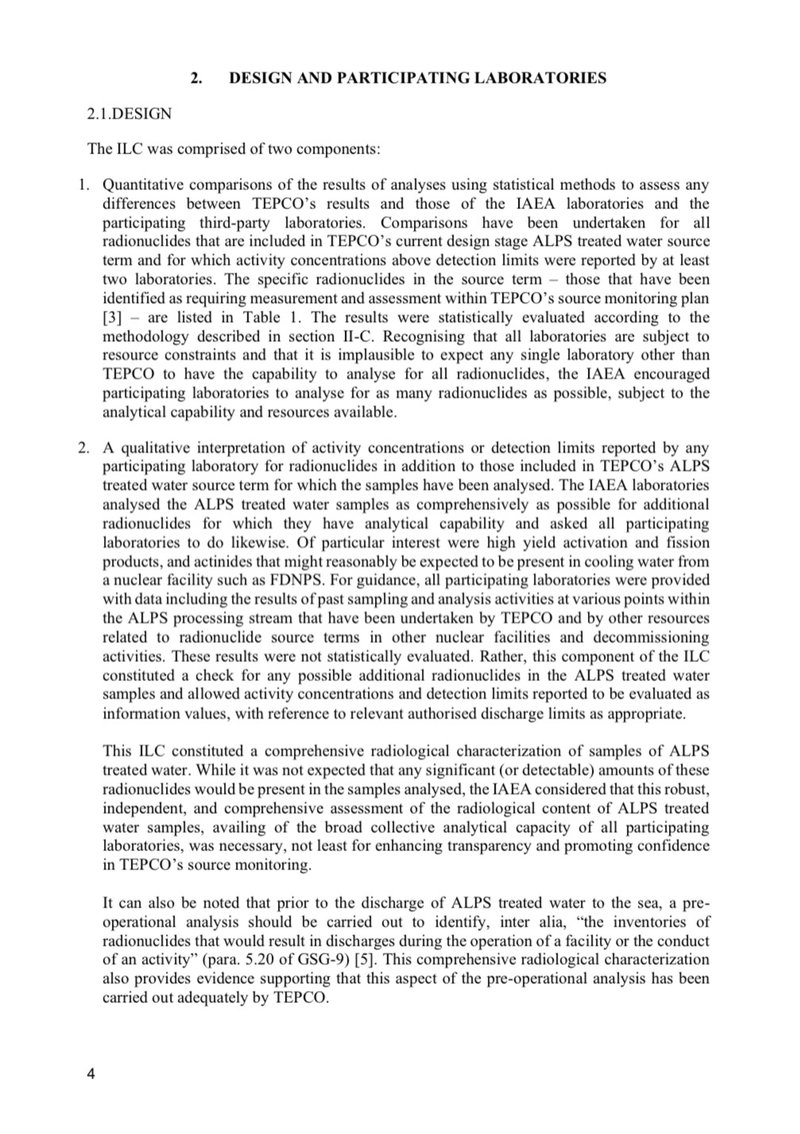
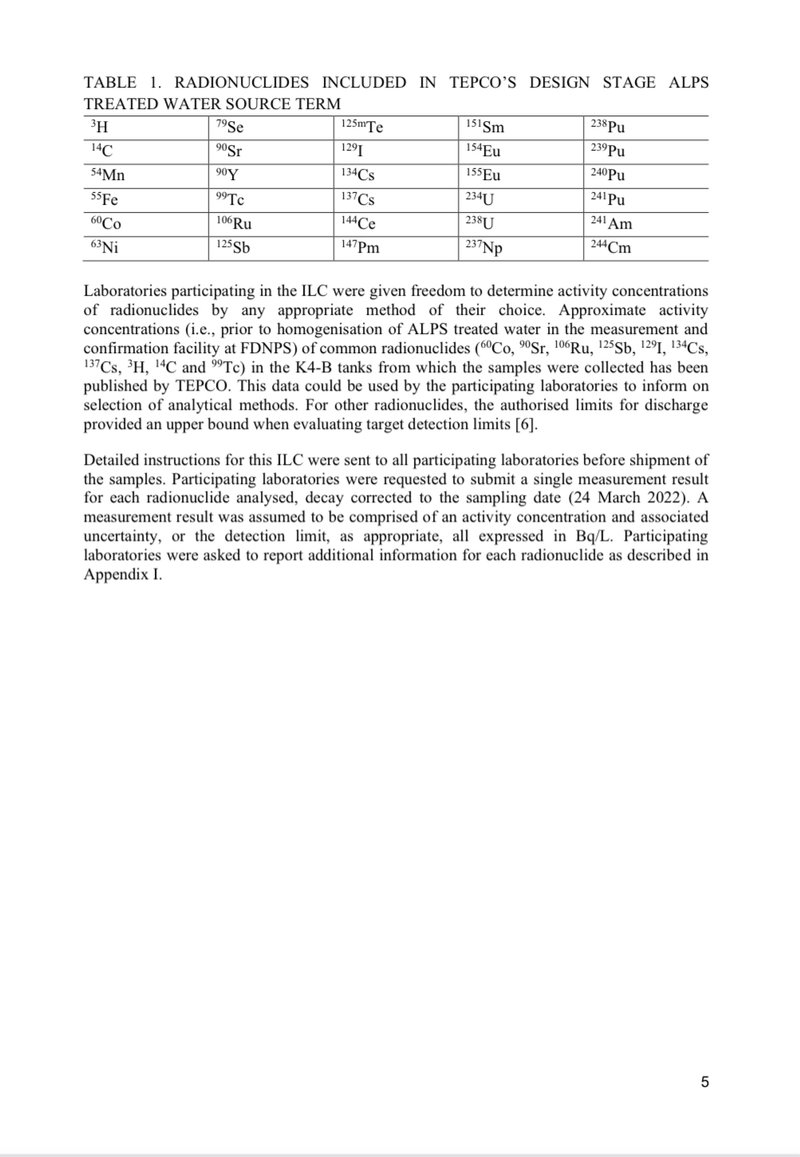
2. DESIGN AND PARTICIPATING LABORATORIES
2.1.DESIGN
The ILC was comprised of two components:
1. Quantitative comparisons of the results of analyses using statistical methods to assess any differences between TEPCO’s results and those of the IAEA laboratories and the participating third-party laboratories. Comparisons have been undertaken for all radionuclides that are included in TEPCO’s current design stage ALPS treated water source term and for which activity concentrations above detection limits were reported by at least two laboratories. The specific radionuclides in the source term – those that have been identified as requiring measurement and assessment within TEPCO’s source monitoring plan [3] – are listed in Table 1. The results were statistically evaluated according to the methodology described in section II-C. Recognising that all laboratories are subject to resource constraints and that it is implausible to expect any single laboratory other than TEPCO to have the capability to analyse for all radionuclides, the IAEA encouraged participating laboratories to analyse for as many radionuclides as possible, subject to the analytical capability and resources available.
2. A qualitative interpretation of activity concentrations or detection limits reported by any participating laboratory for radionuclides in addition to those included in TEPCO’s ALPS treated water source term for which the samples have been analysed. The IAEA laboratories analysed the ALPS treated water samples as comprehensively as possible for additional radionuclides for which they have analytical capability and asked all participating laboratories to do likewise. Of particular interest were high yield activation and fission products, and actinides that might reasonably be expected to be present in cooling water from a nuclear facility such as FDNPS. For guidance, all participating laboratories were provided with data including the results of past sampling and analysis activities at various points within the ALPS processing stream that have been undertaken by TEPCO and by other resources related to radionuclide source terms in other nuclear facilities and decommissioning activities. These results were not statistically evaluated. Rather, this component of the ILC constituted a check for any possible additional radionuclides in the ALPS treated water samples and allowed activity concentrations and detection limits reported to be evaluated as information values, with reference to relevant authorised discharge limits as appropriate.
This ILC constituted a comprehensive radiological characterization of samples of ALPS treated water. While it was not expected that any significant (or detectable) amounts of these radionuclides would be present in the samples analysed, the IAEA considered that this robust, independent, and comprehensive assessment of the radiological content of ALPS treated water samples, availing of the broad collective analytical capacity of all participating laboratories, was necessary, not least for enhancing transparency and promoting confidence in TEPCO’s source monitoring.
It can also be noted that prior to the discharge of ALPS treated water to the sea, a pre- operational analysis should be carried out to identify, inter alia, “the inventories of radionuclides that would result in discharges during the operation of a facility or the conduct of an activity” (para. 5.20 of GSG-9) [5]. This comprehensive radiological characterization also provides evidence supporting that this aspect of the pre-operational analysis has been carried out adequately by TEPCO.
Laboratories participating in the ILC were given freedom to determine activity concentrations of radionuclides by any appropriate method of their choice. Approximate activity concentrations (i.e., prior to homogenisation of ALPS treated water in the measurement and confirmation facility at FDNPS) of common radionuclides (60Co, 90Sr, 106Ru, 125Sb, 129I, 134Cs, 137Cs, 3H, 14C and 99Tc) in the K4-B tanks from which the samples were collected has been published by TEPCO. This data could be used by the participating laboratories to inform on selection of analytical methods. For other radionuclides, the authorised limits for discharge provided an upper bound when evaluating target detection limits [6].
Detailed instructions for this ILC were sent to all participating laboratories before shipment of the samples. Participating laboratories were requested to submit a single measurement result for each radionuclide analysed, decay corrected to the sampling date (24 March 2022). A measurement result was assumed to be comprised of an activity concentration and associated uncertainty, or the detection limit, as appropriate, all expressed in Bq/L. Participating laboratories were asked to report additional information for each radionuclide as described in Appendix I.
2.1.DESIGN
ILCは2つの要素で構成されている:
1. 1.統計的手法を用いた分析結果の定量的比較により、東京電力の結果と IAEAの試験所および参加した第三者試験所の結果との差異を評価する。比較は、東京電力の現在の設計段階である ALPS 処理水ソースタームに含まれ、少なくとも2つの検査機関から検出限界以上の放射能濃度が報告されたすべての放射性核種について実施された。ソースタームに含まれる特定の放射性核種(TEPCOのソースモニタリング計画[3]において測定および評価が必要であると特定された核種)は、表1に記載されている。結果は、セクション II-Cに記載された方法論に従って統計的に評価された。すべての試験所がリソースの制約を受け、TEPCO以外の単一の試験所がすべての放射性核種を分析する能力を持つことを期待するのは不可能であることを認識し、IAEAは参加試験所に対し、分析能力と利用可能なリソースを条件として、可能な限り多くの放射性核種を分析するよう奨励した。
2. 試料が分析されたTEPCOのALPS処理水ソースタームに含まれる放射性核種に加えて、参加試験所から報告された放射能濃度または検出限界の定性的解釈。IAEAの各研究所は、分析能力を有する追加放射性核種について、ALPS処理水試料を可能な限り包括的に分析し、すべての参加研究機関にも同様の分析を依頼した。特に関心が高かったのは、FDNPSのような原子力施設からの冷却水に含まれると合理的に予想される高収率放射化生成物や核分裂生成物、アクチニドであった。ガイダンスのため、すべての参加研究機関は、他の原子力施設や廃炉活動での放射性核種の線源条件に関連し、東京電力や他の情報源によって実施された、ALPSの処理流れの様々な地点での過去のサンプリングと分析活動の結果を含むデータを提供された。これらの結果は統計的に評価されていない。むしろ、ILCのこの構成要素は、ALPS処理水サンプルに含まれる可能性のある追加放射性核種をチェックするものであり、報告された放射能濃度と検出下限値を、必要に応じて関連する認可排出制限値を参照しながら、情報値として評価することを可能にするものであった。
このILCは、ALPS処理水のサンプルの包括的な放射線学的特性評価を構成する。これらの放射性核種が、分析されたサンプル中に有意に(あるいは検出可能な量)存在するとは予想されていなかったが、IAEAは、ALPS処理水サンプルの放射性物質含有量について、参加全研究所の広範な集団分析能力を活用した、強固で独立した包括的な評価が、少なくとも透明性を高め、東京電力の放出源モニタリングに対する信頼を促進するために必要であると考えた。
また、ALPS処理水の海洋排出に先立ち、特に「施設の運転中または活動の実施中に排出される放射性核種のインベントリ」(GSG-9のパラ5.20)[5]を特定するために、運転前分析が実施されなければならないことにも留意されたい。この包括的な放射性核種の特性評価もまた、運転前分析のこの側面が東京電力によって適切に実施されたことを裏付ける証拠となる。
ILCに参加する研究室は、各自が選択した適切な方法で放射性核種の放射能濃度を測定する自由を与えられた。試料が採取された K4-B タンクにおける一般的な放射性核種(60Co、90Sr、106Ru、 125Sb、129I、134Cs、137Cs、3H、14C および 99Tc)のおおよその放射能濃度(すなわち、FDNPSの測定確認施設で ALPS 処理水を均質化する前の濃度)が東京電力によって公表されている。このデータは、参加研究室が分析法を選択する際に利用できる。その他の放射性核種については、目標検出下限を評価する際に、排出の認可下限が上限となる[6]。
このILCに関する詳細な指示は、サンプルの出荷前にすべての参加試験所に送られた。参加検査施設は、分析した各核種について、サンプリング日(2022年3月24日)に減衰補正した単一の測定結果を提出するよう要請された。測定結果は、放射能濃度とそれに関連する不確かさ、または検出限界から構成されるものとし、適宜、すべてBq/Lで表した。参加検査機関は、付録 I に記載されているように、各核種について追加情報を報告するよう求められた。
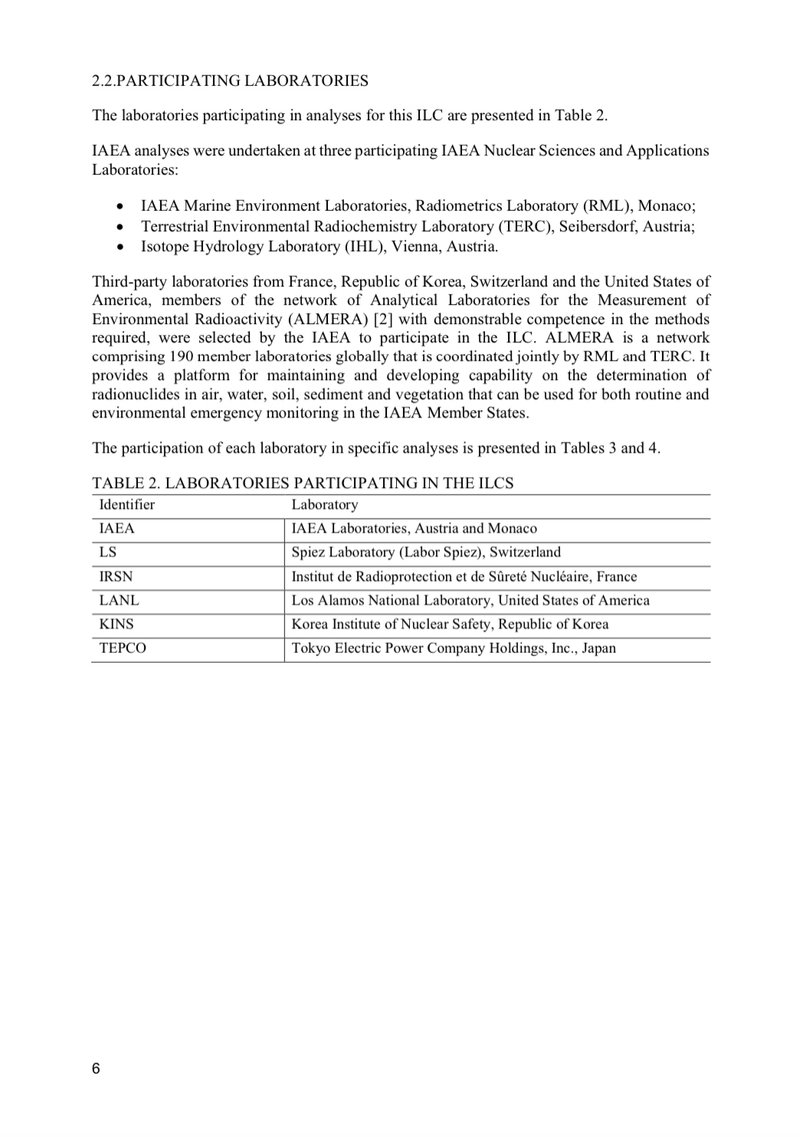


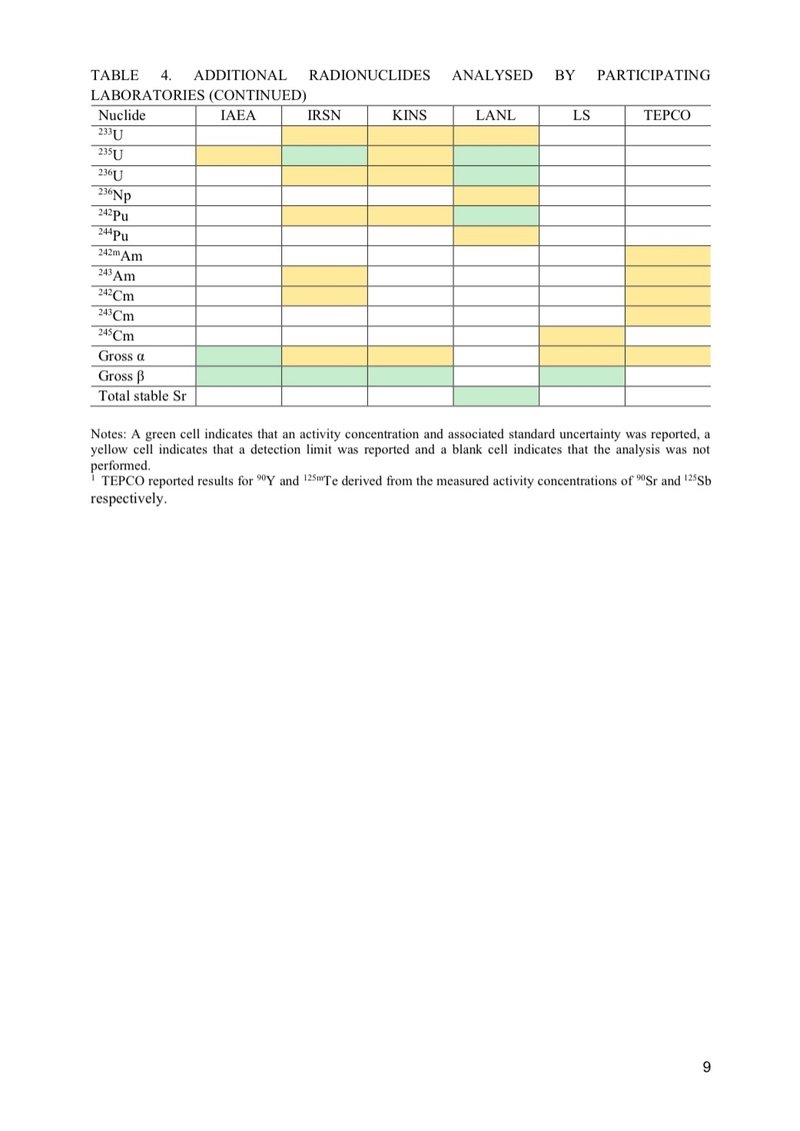
2.2.PARTICIPATING LABORATORIES
The laboratories participating in analyses for this ILC are presented in Table 2.
IAEA analyses were undertaken at three participating IAEA Nuclear Sciences and Applications Laboratories:
• IAEA Marine Environment Laboratories, Radiometrics Laboratory (RML), Monaco;
• Terrestrial Environmental Radiochemistry Laboratory (TERC), Seibersdorf, Austria;
• Isotope Hydrology Laboratory (IHL), Vienna, Austria.
Third-party laboratories from France, Republic of Korea, Switzerland and the United States of America, members of the network of Analytical Laboratories for the Measurement of Environmental Radioactivity (ALMERA) [2] with demonstrable competence in the methods required, were selected by the IAEA to participate in the ILC. ALMERA is a network comprising 190 member laboratories globally that is coordinated jointly by RML and TERC. It provides a platform for maintaining and developing capability on the determination of radionuclides in air, water, soil, sediment and vegetation that can be used for both routine and environmental emergency monitoring in the IAEA Member States.
The participation of each laboratory in specific analyses is presented in Tables 3 and 4.
2.2.参加分析機関
本ILCの分析に参加した研究所を表2に示す。
IAEAの分析は、参加した3つのIAEA原子力科学・応用研究所で実施された:
・IAEA海洋環境研究所、モナコのラジオメトリックス研究所(RML);
・陸域環境放射化学研究所(TERC)、ザイバースドルフ、オーストリア;
・同位体水文学研究所(IHL)、ウィーン、オーストリア
IAEAは、ILCに参加する第三者機関として、フランス、韓国、スイス、米国から、必要とされる手法の能力が実証されている環境放射能測定分析試験所ネットワーク(ALMERA)[2]のメンバーである試験所を選定した。ALMERAは、RMLとTERCが共同で調整する世界190の加盟試験所からなるネットワークである。ALMERAは、IAEA加盟国の大気、水、土壌、堆積物、植生中の放射性核種の定量に関する能力を維持・開発するためのプラットフォームを提供し、日常的なモニタリングと環境緊急時のモニタリングの両方に利用できる。
特定の分析における各研究所の参加状況は、表3と表4に示されている。

3.COLLECTION AND PREPARATION OF ALPS TREATED WATER SAMPLES
Samples for this ILC were collected on 24 March 2022 from the K4-B ALPS facility at FDNPS, with observation by IAEA staff members.
The K4-B tank group is one of three measurement and confirmation units in the ALPS discharge facility that was under construction at FDNPS at that time. It is comprised of 10 individual 1,000 m3 storage tanks that have been re-utilized for this purpose. The tanks are interconnected and the contents are circulated by pumping. Additionally, the water in individual tanks is agitated Previously, TEPCO had performed a circulation and agitation experiment at K4-B to demonstrate the adequacy of its method for ensuring the homogenisation of the ALPS treated water content prior to sampling [7]. Once the discharge facility has been completed, this will become normal practice under TEPCO’s source monitoring plan.
Prior to sampling for this ILC, circulation and agitation was conducted in the same way by TEPCO for 14 days to ensure inter sample homogeneity and, thus, suitability of the samples for the provision of comparable results of analyses.
The samples were collected directly from one of the interconnection pipes at K4-B. A volume of 25.3 L of ALPS treated water was collected for each participating laboratory: 5 x 5 L in plastic cubitainers and 3 x 100 mL in amber glass bottles. The sample containers were assigned and labelled beforehand and were immediately sealed with tamper proof tape under IAEA observation. The samples were not acidified or filtered prior to shipping.
The samples were received by the IAEA laboratories in Monaco and Austria and by the participating ALMERA laboratories between August and October 2022.
3.ALPS処理水サンプルの採取と調製
本ILC用サンプルは、2022年3月24日にFDNPS のK4-B ALPS施設から、IAEAスタッフの立会いの下、採取された。K4-Bタンク群は、当時FDNPSに建設中であったALPS放出施設の3つの測定確認ユニットのうちの1つであり、この目的のために再利用された10基の個別の1,000m3貯蔵タンクで構成されている。タンクは相互に連結され、中身はポンプで循環される。さらに、個々のタンク内の水は撹拌される。以前、東京電力は、サンプリング前にALPS処理水の均質化を確実にする方法の妥当性を実証するために、K4-Bで循環撹拌実験を行った[7]。放流施設が完成すれば、これは東京電力のソースモニタリング計画における通常の慣行となる。このILCのためのサンプリングに先立ち、東京電力は14日間同じ方法で循環撹拌を行い、サンプル間の均質性を確保し、その結果、比較可能な分析結果を提供するためのサンプルの適合性を確保した。サンプルはK4-Bの連系配管の1本から直接採取した。ALPS処理水25.3Lを参加ラボごとに採取した: プラスチック製キュービテーナーに5x5L、琥珀色のガラス瓶に3x100mLを入れた。サンプル容器は事前に指定され、ラベルが貼られ、IAEAの監視のもと、直ちに改ざん防止テープで密封された。サンプルは出荷前に酸性化やろ過は行わなかった。サンプルは2022年8月から10月の間に、モナコとオーストリアのIAEAラボ、および参加したALMERAラボで受領された。
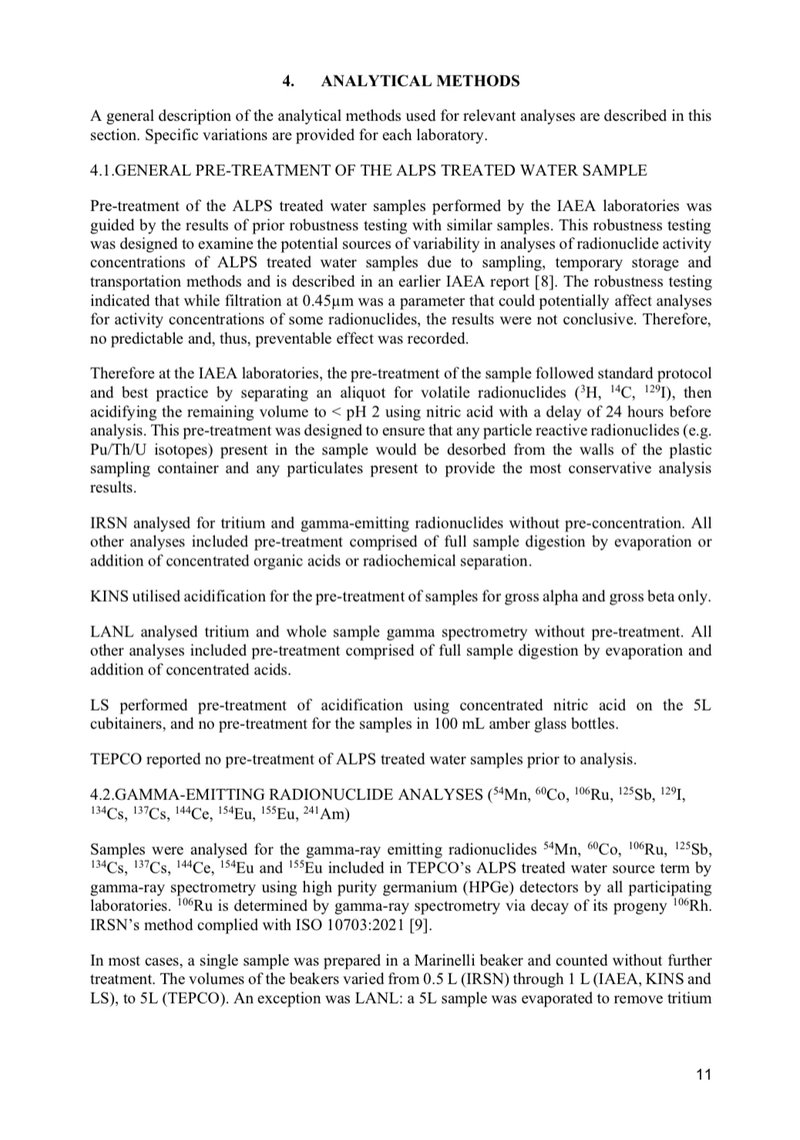
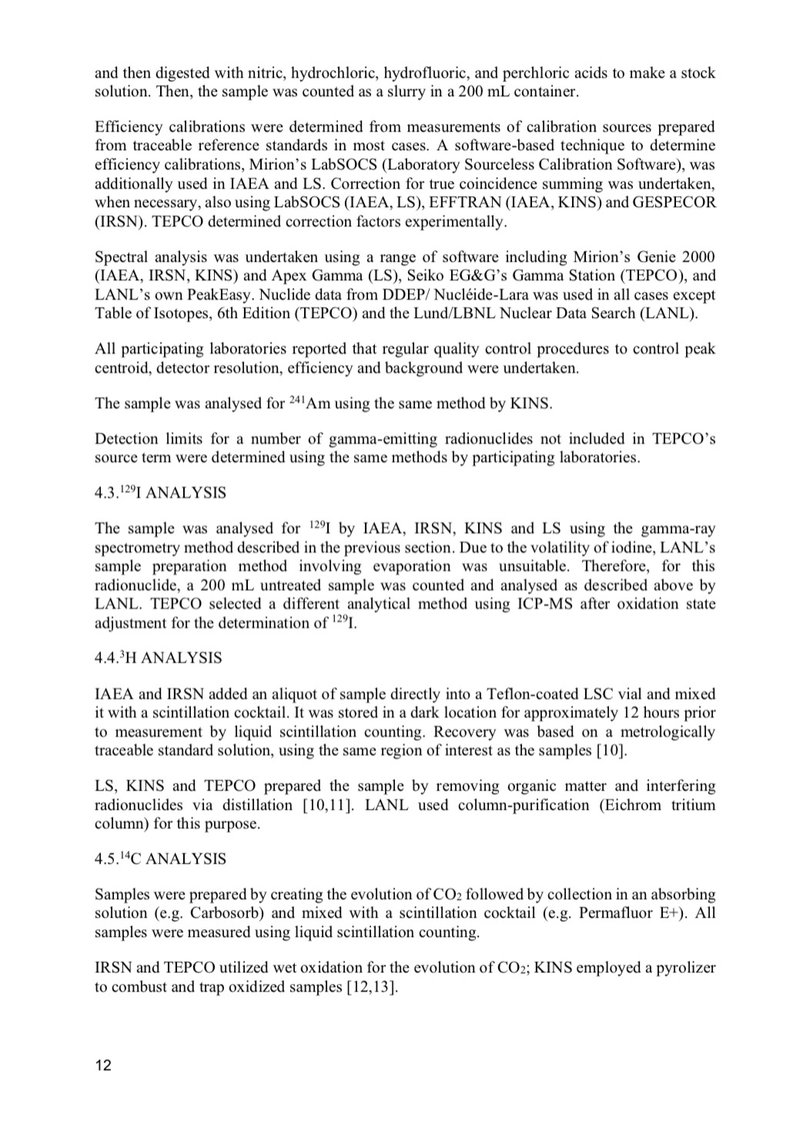



4.ANALYTICAL METHODS
A general description of the analytical methods used for relevant analyses are described in this section. Specific variations are provided for each laboratory.
4.1.GENERAL PRE-TREATMENT OF THE ALPS TREATED WATER SAMPLE
Pre-treatment of the ALPS treated water samples performed by the IAEA laboratories was guided by the results of prior robustness testing with similar samples. This robustness testing was designed to examine the potential sources of variability in analyses of radionuclide activity concentrations of ALPS treated water samples due to sampling, temporary storage and transportation methods and is described in an earlier IAEA report [8]. The robustness testing indicated that while filtration at 0.45μm was a parameter that could potentially affect analyses for activity concentrations of some radionuclides, the results were not conclusive. Therefore, no predictable and, thus, preventable effect was recorded.
Therefore at the IAEA laboratories, the pre-treatment of the sample followed standard protocol and best practice by separating an aliquot for volatile radionuclides (3H, 14C, 129I), then acidifying the remaining volume to < pH 2 using nitric acid with a delay of 24 hours before analysis. This pre-treatment was designed to ensure that any particle reactive radionuclides (e.g. Pu/Th/U isotopes) present in the sample would be desorbed from the walls of the plastic sampling container and any particulates present to provide the most conservative analysis results.
IRSN analysed for tritium and gamma-emitting radionuclides without pre-concentration. All other analyses included pre-treatment comprised of full sample digestion by evaporation or addition of concentrated organic acids or radiochemical separation.
KINS utilised acidification for the pre-treatment of samples for gross alpha and gross beta only.
LANL analysed tritium and whole sample gamma spectrometry without pre-treatment. All other analyses included pre-treatment comprised of full sample digestion by evaporation and addition of concentrated acids.
LS performed pre-treatment of acidification using concentrated nitric acid on the 5L cubitainers, and no pre-treatment for the samples in 100 mL amber glass bottles.
TEPCO reported no pre-treatment of ALPS treated water samples prior to analysis.
4.2.GAMMA-EMITTING RADIONUCLIDE ANALYSES (54Mn, 60Co, 106Ru, 125Sb, 129I, 134Cs, 137Cs, 144Ce, 154Eu, 155Eu, 241Am)
Samples were analysed for the gamma-ray emitting radionuclides 54Mn, 60Co, 106Ru, 125Sb, 134Cs, 137Cs, 144Ce, 154Eu and 155Eu included in TEPCO’s ALPS treated water source term by gamma-ray spectrometry using high purity germanium (HPGe) detectors by all participating laboratories. 106Ru is determined by gamma-ray spectrometry via decay of its progeny 106Rh. IRSN’s method complied with ISO 10703:2021 [9].
In most cases, a single sample was prepared in a Marinelli beaker and counted without further treatment. The volumes of the beakers varied from 0.5 L (IRSN) through 1 L (IAEA, KINS and LS), to 5L (TEPCO). An exception was LANL: a 5L sample was evaporated to remove tritium and then digested with nitric, hydrochloric, hydrofluoric, and perchloric acids to make a stock solution. Then, the sample was counted as a slurry in a 200 mL container.
Efficiency calibrations were determined from measurements of calibration sources prepared from traceable reference standards in most cases. A software-based technique to determine efficiency calibrations, Mirion’s LabSOCS (Laboratory Sourceless Calibration Software), was additionally used in IAEA and LS. Correction for true coincidence summing was undertaken, when necessary, also using LabSOCS (IAEA, LS), EFFTRAN (IAEA, KINS) and GESPECOR (IRSN). TEPCO determined correction factors experimentally.
Spectral analysis was undertaken using a range of software including Mirion’s Genie 2000 (IAEA, IRSN, KINS) and Apex Gamma (LS), Seiko EG&G’s Gamma Station (TEPCO), and LANL’s own PeakEasy. Nuclide data from DDEP/ Nucléide-Lara was used in all cases except Table of Isotopes, 6th Edition (TEPCO) and the Lund/LBNL Nuclear Data Search (LANL).
All participating laboratories reported that regular quality control procedures to control peak centroid, detector resolution, efficiency and background were undertaken.
The sample was analysed for 241Am using the same method by KINS.
Detection limits for a number of gamma-emitting radionuclides not included in TEPCO’s source term were determined using the same methods by participating laboratories.
4.3. 129I ANALYSIS
The sample was analysed for 129I by IAEA, IRSN, KINS and LS using the gamma-ray spectrometry method described in the previous section. Due to the volatility of iodine, LANL’s sample preparation method involving evaporation was unsuitable. Therefore, for this radionuclide, a 200 mL untreated sample was counted and analysed as described above by LANL. TEPCO selected a different analytical method using ICP-MS after oxidation state adjustment for the determination of 129I.
4.4.3H ANALYSIS
IAEA and IRSN added an aliquot of sample directly into a Teflon-coated LSC vial and mixed it with a scintillation cocktail. It was stored in a dark location for approximately 12 hours prior to measurement by liquid scintillation counting. Recovery was based on a metrologically traceable standard solution, using the same region of interest as the samples [10].
LS, KINS and TEPCO prepared the sample by removing organic matter and interfering radionuclides via distillation [10,11]. LANL used column-purification (Eichrom tritium column) for this purpose.
4.5.14C ANALYSIS
Samples were prepared by creating the evolution of CO2 followed by collection in an absorbing solution (e.g. Carbosorb) and mixed with a scintillation cocktail (e.g. Permafluor E+). All samples were measured using liquid scintillation counting.
IRSN and TEPCO utilized wet oxidation for the evolution of CO2; KINS employed a pyrolizer to combust and trap oxidized samples [12,13].
4.6.90Sr ANALYSIS
All laboratories followed the general procedure to selectively remove impurities and interfering nuclides using extractive chromatographic resin, and gravimetric recovery of Sr ions via strontium carbonate precipitation.
The removal of impurities and interfering radionuclides can be achieved using multiple techniques. IAEA, IRSN and LS used dicyclohexyl-18-crown-6-ether-based Sr resin column and KINS used cation exchange resin (Dowex 50W-X8) [14,15].
IAEA and KINS measured Sr-90 using liquid scintillation counting, LS used 90Sr by low level gas proportional counting [16] while TEPCO used a plastic scintillation detector [17].
4.7.55Fe ANALYSIS
IAEA, LS, IRSN and KINS used an anion chromatography resin (e.g. 1-X4 Biorad) for chemical separation of 55Fe from the sample matrix followed by liquid scintillation counting [18]. TEPCO selected a different analytical method using an anion chromatography resin for chemical separation, hydroxide precipitation for source preparation and a low-energy photon detector (Ge-LEPS) for analysis [19,20].
IAEA results were provided by subcontractor Laboratorio de Medidas de Baja Actividad de la Universidad del Pais Vasco, accreditation number 350/LE560 under Entidad Nacional de Accreditacion.
4.8.63Ni ANALYSIS
All laboratories used a chemical separation with an anion exchange resin (e.g. 1-X4 Biorad) followed by a selective Ni extractive chromatographic resin to extract 63Ni from the sample matrix. Measurements were conducted by liquid scintillation counting [18,21].
IAEA results were provided by subcontractor Laboratorio de Medidas de Baja Actividad de la Universidad del Pais Vasco, accreditation number 350/LE560 under Entidad Nacional de Accreditacion.
4.9.99Tc ANALYSIS
IAEA, LS, IRSN and KINS separated 99Tc from the sample matrix using an extractive chromatographic resin [22]. Analysis was then performed by ICP-MS. Spiez utilised sf-ICP- MS [23].
TEPCO did not separate 99Tc from the sample matrix and used a simple dilution followed by analysis using ICP-MS [21].
IAEA results were provided by subcontractor Laboratorio de Medidas de Baja Actividad de la Universidad del Pais Vasco, accreditation number 350/LE560 under Entidad Nacional de Accreditacion.
4.10. 79Se ANALYSIS
After selective removal of impurities and interfering nuclides by sedimentation and TEVA resin, hydroxylamine hydrochloride was added to precipitate Se. After filtering, dissolution and mixing with scintillation cocktails, 79Se was measured using liquid scintillation counting [21].
4.11. GROSS ALPHA ANALYSIS
Gross alpha analysis is used to screen the total alpha emitting radionuclide content in the sample by either direct count, preconcentration (evaporation, co-precipitation) and measurement.
IAEA removed alkali and alkaline earth metal ions using a calcium phosphate co-precipitation. The precipitation was then dissolved in 2M H3PO4 and scintillation cocktail added. Measurement of gross alpha activity was performed using liquid scintillation counting [24,25].
LS utilised a direct counting method where filtered sample was mixed with Ultima Gold AB and measurements were performed using liquid scintillation counter.
KINS pre-concentrated the sample which was transferred onto a planchette and dried. Measurements were performed using alpha-beta counter [24].
IRSN performed gross alpha by evaporation of a known volume of water on a stainless-steel disk with the use of a ZnS scintillator detector [26,27].
At TEPCO, alkali and alkaline earth metal ions were removed via Fe(III) hydroxide co- precipitation. Precipitation was dissolved in HCl and Fe ions were removed by solvent extraction using 2,6-Dimethyl-4-heptanone. The aqueous phase was collected and dried into a solid. Gross alpha activity of the so-prepared sample was conducted on ZnS(Ag) plastic scintillation detector [28].
4.12. ALPHA-EMITTING RADIONUCLIDE ANALYSIS
Selective removal of impurities and interference radionuclides sample matrix using an extractive chromatographic resin, with recovery measured via addition of suitable tracers. Sources for alpha-particle spectrometry were prepared by electrodeposition on stainless steel discs or via micro co-precipitation.
LS measured the separated actinides (241Am, 244Cm, 237Np, 239Pu, 240Pu, 234U and 238U) using sf-ICP-MS [29,30].
IRSN followed ISO 13167:2015 using alpha spectrometry to measure 238Pu, 239+240Pu, 241Am and 243,244Cm [31]. Additional radionuclides 242Pu, 243Am, and 242Cm were measured using the same method. 233U, 234U, 238U 235U and 236U were measured by ICP-MS isotopic dilution with an internal isotopic standard [32].
KINS performed the analysis of 237Np, 239Pu, 240Pu and 241Pu by ICP-MS.
LANL pre-treated samples using evaporation to remove tritium. Chemical separations including precipitations and anion exchange chromatography were performed and samples were measured using either dynamic multi-ion counting or multi-static total evaporation TIMS analysis. Samples were analysed for 236Np, 237Np, 239Pu, 240Pu, 241Pu, 242Pu, 244Pu 233U, 235U, 236U, 234U and 238U. Additionally, LANL measured 230Th and 232Th by multi-ion counting ICP- MS.
4.13. ADDITIONAL RADIONUCIDES IN TEPCO’S SOURCE TERM
For three radionuclides, 241Pu, 147Pm and 151Sm, TEPCO reported results that have been calculated from measurements of the activity concentrations of other “reference” radionuclides (𝐶𝑟𝑒𝑓𝑒𝑟𝑒𝑛𝑐𝑒) in the source term and scaled using the ratio of the FDNPS reactor inventory estimates 𝐼𝑚𝑒𝑎𝑠𝑢𝑟𝑒𝑒𝑑 and 𝐼𝑟𝑒𝑓𝑒𝑟𝑒𝑛𝑐𝑒 for the two radionuclides:
𝐶 = 𝐶 𝐼𝑐𝑎𝑙𝑐𝑢𝑙𝑎𝑡𝑒𝑑 𝑐𝑎𝑙𝑐𝑢𝑙𝑎𝑡𝑒𝑑 𝑟𝑒𝑓𝑒𝑟𝑒𝑛𝑐𝑒 𝐼𝑟𝑒𝑓𝑒𝑟𝑒𝑛𝑐𝑒
241Pu was calculated from measurements of 238Pu, and both 147Pm and 151Sm from 154Eu. The inventory activities and reference radionuclides are listed in Table I-7 of TEPCO’s design stage REIA [3]. The methodology to estimate the inventory, part of the characterisation of the ALPS treated water source that has been undertaken by TEPCO, is also described in detail the REIA. A summary of provided in an earlier IAEA report [33].
Results for additional radionuclides not included in the source term were determined using the same method and reported by TEPCO.
4.ANALYTICAL METHOD
関連する分析に使用された分析方法の一般的な説明を本節に記載する。
4.1.GENERAL ALPS 処理水サンプルの前処理
IAEA の試験所が実施した ALPS 処理水試料の前処理は、類似試料を用いた事前の頑健性試験の結果に基づいて行われた。このロバストネス試験は、サンプリング、一時保管、輸送方法に起因するALPS処理水サンプルの放射性核種放射能濃度の分析における潜在的な変動源を調べるために設計され、以前のIAEA報告書[8]に記載されている。頑健性試験の結果、0.45μm でのろ過は、いくつかの放射性核種の放射能濃度の分析に潜在的な影響を及ぼす可能性のあるパラメータであることが示されたが、その結果は決定的なものではなかった。そのため、IAEAの研究所では、サンプルの前処理は、揮発性放射性核種(3H、14C、129I)用のアリコートを分離し、分析前に24時間遅れで残りの容量を硝酸を用いてpH2未満まで酸性化するという、標準的なプロトコルとベストプラクティスに従って行われた。この前処理は、試料中に存在する粒子反応性放射性核種(Pu/Th/U同位体など)がプラスチックサンプリング容器の壁や存在する微粒子から確実に脱着され、最も保守的な分析結果が得られるように設計された。KINSは、グロスアルファとグロスベータのみのサンプルの前処理に酸性化を利用した。LANLは、前処理なしでトリチウムと全サンプルのガンマスペクトロメトリーを分析した。LSは5Lキュービテナーで濃硝酸を用いた酸性化の前処理を行い、100mLの琥珀色のガラス瓶に入った試料については前処理を行わなかった。
4.2. ガンマ線放出核種分析 (54Mn, 60Co, 106Ru, 125Sb, 129I, 134Cs, 137Cs, 144Ce, 154Eu, 155Eu, 241Am)
134Cs、137Cs、144Ce、154Eu、および155Euは、高純度ゲルマニウム(HPGe)検出器を用いたガンマ線スペクトロメトリーにより、TEPCOのALPS処理水ソースタームに含まれている。106Ruは、子孫核種106Rhの崩壊を経由してガンマ線スペクトロメトリーにより決定される。IRSNの方法はISO 10703:2021に準拠している[9]。ほとんどの場合、単一のサンプルがマリネッリビーカーに調製され、それ以上の処理は行われずに計数された。ビーカーの容量は0.5L(IRSN)から1L(IAEA、KINS、LS)、5L(TEPCO)まで様々であった。例外はLANLで、5Lのサンプルを蒸発させてトリチウムを除去し、硝酸、塩酸、フッ酸、過塩素酸で消化してストック溶液を作りました。効率校正は、ほとんどの場合、トレーサブルな標準物質から調製された校正源の測定値から決定されました。IAEAとLSでは、効率校正を決定するためのソフトウェアベースの技術、MirionのLabSOCS(Laboratory Sourceless Calibration Software)が追加的に使用された。真の同時計数補正は、必要に応じてLabSOCS(IAEA、LS)、EFFTRAN(IAEA、KINS)およびGESPECOR(IRSN)を使用して行われた。スペクトル解析は、MirionのGenie 2000(IAEA、IRSN、KINS)およびApex Gamma(LS)、セイコーEG&GのGamma Station(TEPCO)、LANL独自のPeakEasyなど、さまざまなソフトウェアを使用して行われました。DDEP/Nucléide-Laraの核種データは、Table of Isotopes, 6th Edition (TEPCO)とLund/LBNL Nuclear Data Search (LANL)を除くすべてのケースで使用された。すべての参加ラボは、ピーク重心、検出器分解能、効率、バックグラウンドを管理するための定期的な品質管理手順が実施されたことを報告した。 試料は、KINSによって同じ方法で241Amについて分析された。TEPCOの線源項に含まれていない多くのガンマ線放出核種の検出下限値は、参加した研究所によって同じ方法で決定された。
4.3. 129I 分析
試料は、IAEA、IRSN、KINS、LS により、前節で述べたガンマ線スペクトロメトリー法を用いて 129I が分析された。ヨウ素の揮発性のため、蒸発を含むLANLの試料調製法は不適当であった。そのため、この放射性核種については、200mLの未処理試料を、LANLが上記で説明した方法で計数・分析した。東京電力は、129Iの測定に酸化状態調整後のICP-MSを使用する別の分析方法を選択した。
4.4.3H分析
IAEAとIRSNは、テフロン加工のLSCバイアル瓶にサンプルのアリコートを直接加え、シンチレーションカクテルと混合した。液体シンチレーションカウンティングによる測定の前に、約12時間暗所に保管した。LS、KINSおよびTEPCOは、蒸留によって有機物および妨害放射性核種を除去することによって試料を調製した[10,11]。LANLはこの目的のためにカラム精製(Eichromトリチウムカラム)を使用した。
4.5.14C分析
試料は、CO2を発生させた後、吸収液(Carbosorbなど)に捕集し、シンチレーションカクテル(Permafluor E+など)と混合して調製した。IRSNとTEPCOはCO2の発生に湿式酸化を利用し、KINSはパイロライザーを用いて酸化した試料を燃焼・捕捉した[12,13]。
4.6.90Sr分析
全ての研究室で、抽出クロマト樹脂を用いて不純物や妨害核種を選択的に除去し、炭酸ストロンチウム沈殿を 介してSrイオンを重量法で回収する一般的な手順に従った。IAEA、IRSN、LSはジシクロヘキシル-18-クラウン-6-エーテルベースのSr樹脂カラムを使用し、KINSは陽イオン交換樹脂(Dowex 50W-X8)を使用した[14,15]。IAEAとKINSは液体シンチレーションカウンティングを用いてSr-90を測定し、LSは低レベルガス比例計数法[16]により90Srを測定し、東京電力はプラスチックシンチレーション検出器を使用した[17]。
4.7.55Fe分析
IAEA、LS、IRSNおよびKINSは、試料マトリックスからの55Feの化学分離に陰イオンクロマトグラフ樹脂(例えば1-X4 Biorad)を使用し、その後液体シンチレーション計数を行った[18]。東京電力は、化学分離に陰イオンクロマトグラフ樹脂、線源前処理に水酸化物沈殿、分析に低エネルギー光子検出器(Ge-LEPS)を用いた異なる分析法を選択した[19,20]。IAEAの結果は、Entidad Nacional de Accreditacionの下請けであるLaboratorio de Medidas de Baja Actividad de la Universidad del Pais Vasco(認定番号350/LE560)により提供された。
4.8.63Ni分析
全研究室で陰イオン交換樹脂(例:1-X4 Biorad)による化学分離の後、選択的Ni抽出クロマト樹脂を使用して試料マトリックスから63Niを抽出した。測定は液体シンチレーション計数法 [18,21]で実施された。IAEAの結果は下請け業者であるLaboratorio de Medidas de Baja Actividad de la Universidad del Pais Vasco、Entidad Nacional de Accreditacionの認定番号350/LE560により提供された。
4.9.99Tc分析
IAEA、LS、IRSN、KINSは、抽出クロマト樹脂を用いて試料マトリックスから99Tcを分離した[22]。その後、ICP-MSで分析が行われた。TEPCOは試料マトリックスから99Tcを分離せず、単純希釈を行い、ICP-MSを用いた分析を行った[21]。IAEAの結果は、Entidad Nacional de Accreditacionの認定番号350/LE560の下請け業者であるLaboratorio de Medidas de Baja Actividad de la Universidad del Pais Vascoから提供された。
4.10. 79Se分析
沈殿とTEVA樹脂で不純物と妨害核種を選択的に除去した後、塩酸ヒドロキシルアミンを加えてSeを沈殿させた。濾過、溶解、シンチレーションカクテルとの混合後、液体シンチレーション計数法 [21] を用いて79Seを測定した。
4.11. グロスアルファ分析
グロスアルファ分析は、直接計数、前濃縮(蒸発、共沈)、測定のいずれかにより、試料中の全アルファ放出核種含有量をスクリーニングするために使用される。沈殿を2M H3PO4に溶解し、シンチレーションカクテルを添加した。グロスアルファ放射能測定は、液体シンチレーションカウンティング[24,25]を用いて行った。LSでは、ろ過した試料をUltima Gold ABと混合し、液体シンチレーションカウンターを用いて測定を行う直接計数法を利用した。KINSでは、試料をあらかじめ濃縮し、プランシェットに移して乾燥させた。IRSNは、ZnSシンチレータ検出器を使用し、ステンレス製ディスク上で既知量の水を蒸発させることにより、グロスアルファを行った[26,27]。TEPCOでは、アルカリおよびアルカリ土類金属イオンは、水酸化鉄(III)共沈殿により除去された。沈殿を塩酸に溶解し、2,6-ジメチル-4-ヘプタノンを用いた溶媒抽出により鉄イオンを除去した。水相を集め、乾燥して固体とした。このようにして調製した試料のグロスα放射能をZnS(Ag)プラスチックシンチレーション検出器で測定した[28]。
4.12. アルファ放出放射性核種分析
抽出クロマトグラフィー樹脂を用いて、不純物や干渉放射性核種を選択的に除去し、適切なトレーサーを添加して回収率を測定した。LSは、sf-ICP-MSを用いて分離したアクチニド(241Am、244Cm、237Np、239Pu、240Pu、234U、238U)を測定した[29,30]。IRSNは、ISO 13167:2015に従い、アルファスペクトロメトリーを用いて238Pu、239+240Pu、241Am、243,244Cmを測定した[31]。追加の放射性核種242Pu、243Am、242Cmも同じ方法で測定された。233U、234U、238U、235U、236Uは、内部同位体標準を用いたICP-MS同位体希釈によって測定された[32]。KINSは、237Np、239Pu、240Pu、241PuのICP-MSによる分析を行った。沈殿と陰イオン交換クロマトグラフィーを含む化学分離が実施され、試料は動的マルチイオンカウンティングまたはマルチ静的全蒸発TIMS分析のいずれかを用いて測定された。サンプルは236Np、237Np、239Pu、240Pu、241Pu、242Pu、244Pu 233U、235U、236U、234U、238Uについて分析されました。さらに、LANLはマルチイオンカウンティングICP- MSで230Thと232Thを測定しました。
4.13. 東京電力のソース・タームにおける追加放射性核種
241Pu、147Pm、151Smの3核種について、 東京電力は、ソースターム内の他の「基準」核種(𝐶𝑒𝑓𝑒)の放射能濃度の測定値から計算した結果を報告した。ソースタームで、FDNPSの原子炉インベントリ推定値 𝐶 = 𝐶 𝐼𝑐𝑎𝑙𝑐𝑢𝑙𝑎𝑡𝑒𝑑 𝑐𝑎𝑙𝑐𝑢𝑙𝑎𝑡𝑒𝑑 𝑟𝑒𝑓𝑒𝑟𝑒𝑛𝑐𝑒 𝐼𝑟𝑒𝑓𝑒𝑟𝑒𝑛𝑐𝑒241Pu was calculated from measurements of 238Pu, and both 147Pm and 151Sm from 154Eu. インベントリ活動量と基準核種は、東京電力の設計段階REIA [3]の表I-7に記載されている。インベントリを推定する方法は、東京電力が実施したALPS処理水源の特性評価の一部であり、REIAにも詳細に記載されている。ソースタームに含まれない追加放射性核種に関する結果は、同じ方法を用いて決定され、TEPCOによって報告された。
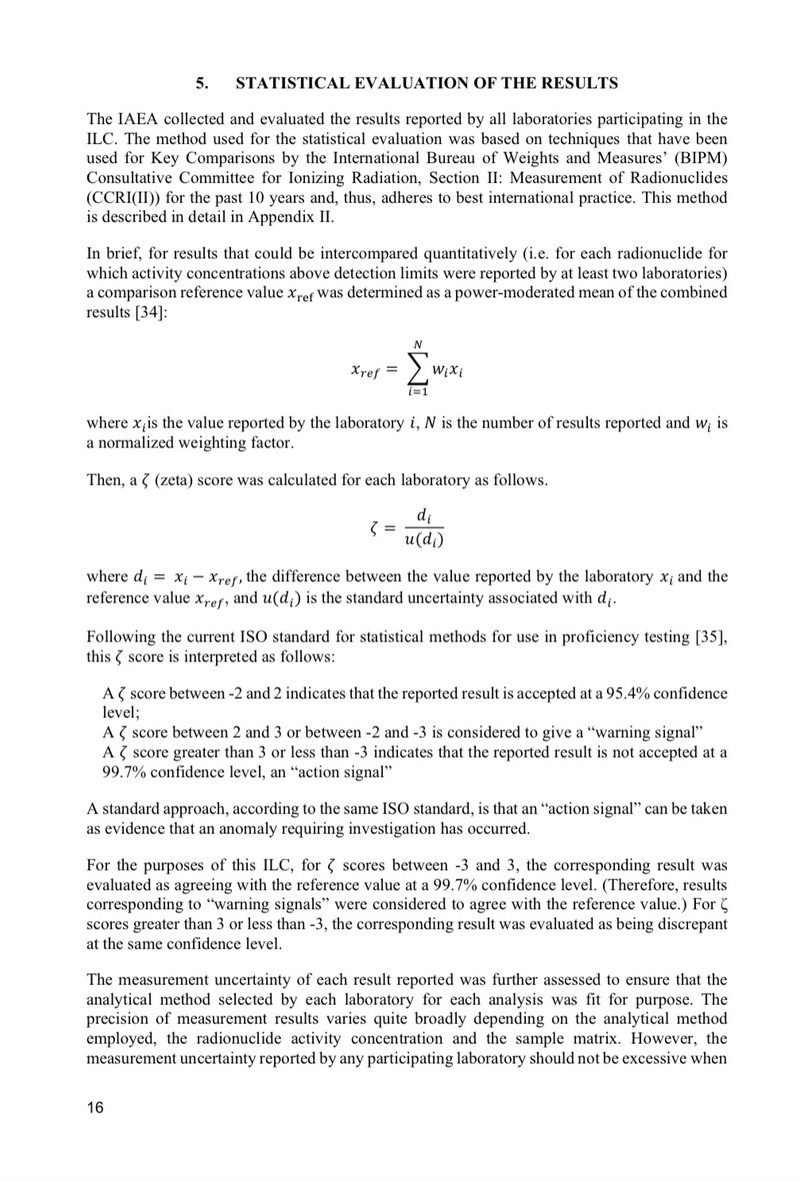

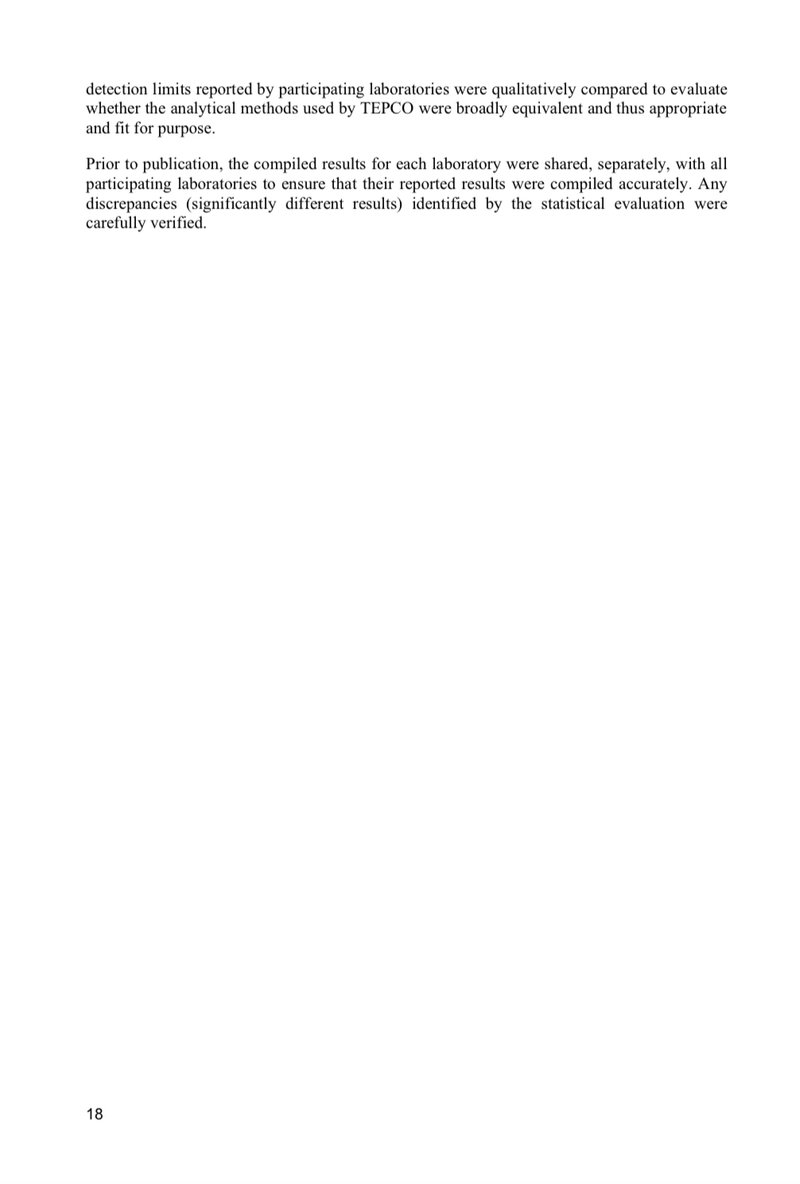
5.STATISTICAL EVALUATION OF THE RESULTS
The IAEA collected and evaluated the results reported by all laboratories participating in the ILC. The method used for the statistical evaluation was based on techniques that have been used for Key Comparisons by the International Bureau of Weights and Measures’ (BIPM) Consultative Committee for Ionizing Radiation, Section II: Measurement of Radionuclides (CCRI(II)) for the past 10 years and, thus, adheres to best international practice. This method is described in detail in Appendix II.
In brief, for results that could be intercompared quantitatively (i.e. for each radionuclide for which activity concentrations above detection limits were reported by at least two laboratories) a comparison reference value 𝑥ref was determined as a power-moderated mean of the combined results [34]:
𝑁
𝑥𝑟𝑒𝑓 = ∑𝑤𝑖𝑥𝑖 𝑖=1
where 𝑥𝑖is the value reported by the laboratory 𝑖, 𝑁 is the number of results reported and 𝑤𝑖 is a normalized weighting factor.
Then, a 𝜁 (zeta) score was calculated for each laboratory as follows. 𝜁= 𝑑𝑖
𝑢(𝑑𝑖)
where 𝑑𝑖 = 𝑥𝑖 − 𝑥𝑟𝑒𝑓, the difference between the value reported by the laboratory 𝑥𝑖 and the
reference value 𝑥𝑟𝑒𝑓, and 𝑢(𝑑𝑖) is the standard uncertainty associated with 𝑑𝑖.
Following the current ISO standard for statistical methods for use in proficiency testing [35],
this 𝜁 score is interpreted as follows:
A 𝜁 score between -2 and 2 indicates that the reported result is accepted at a 95.4% confidence level;
A 𝜁 score between 2 and 3 or between -2 and -3 is considered to give a “warning signal”
A 𝜁 score greater than 3 or less than -3 indicates that the reported result is not accepted at a 99.7% confidence level, an “action signal”
A standard approach, according to the same ISO standard, is that an “action signal” can be taken as evidence that an anomaly requiring investigation has occurred.
For the purposes of this ILC, for 𝜁 scores between -3 and 3, the corresponding result was evaluated as agreeing with the reference value at a 99.7% confidence level. (Therefore, results corresponding to “warning signals” were considered to agree with the reference value.) For ζ scores greater than 3 or less than -3, the corresponding result was evaluated as being discrepant at the same confidence level.
The measurement uncertainty of each result reported was further assessed to ensure that the analytical method selected by each laboratory for each analysis was fit for purpose. The precision of measurement results varies quite broadly depending on the analytical method employed, the radionuclide activity concentration and the sample matrix. However, the measurement uncertainty reported by any participating laboratory should not be excessive when compared to those for the same sample and radionuclide submitted by other laboratories. A precision check was undertaken by comparing each result reported to a multiple of 𝑆50 = 𝑆 × 0.67449, a typical uncertainty for the dataset under consideration, a parameter calculated as part of the determination of the power-moderated mean. For the purposes of this ILC, a reported uncertainty of greater than five times 𝑆50 was considered to be statistically irrelevant.
The difference 𝑑𝑖 between the value reported by the laboratory and the reference value and the combined uncertainty (of the reported value and the reference value) were assessed using a graphical method, the “PomPlot” [36, 37]. This is an intuitive graphical method, also used by the BIPM’s CCRI(II) for Key Comparisons, that provides a summary overview of the results reported by participating laboratories.
The PomPlot displays the difference of each reported result from the reference value on the horizontal axis and the standard uncertainty associated with each difference on the vertical axis. The red point indicates the reference value; and the green, blue and red solid lines represent 𝜁 scores = ±1, ±2 and ±3, respectively. For both axes, the variables are expressed as multiples of 𝑆50, the typical uncertainty for the dataset under consideration as defined above (Figure 2).
Values on the right-hand side of the graph correspond to results that are higher than the reference value while lower values are located on the left. When the reported uncertainty is low, the corresponding point is located high in the graph. The most accurate results should be located close to the top of the pyramid. Points outside of the 𝜁 = ±3 lines are discrepant.
For radionuclides for which results could not be compared quantitatively (i.e. those for which activity concentrations above detection limits were reported by just one laboratory), the detection limits reported by participating laboratories were qualitatively compared to evaluate whether the analytical methods used by TEPCO were broadly equivalent and thus appropriate and fit for purpose.
Prior to publication, the compiled results for each laboratory were shared, separately, with all participating laboratories to ensure that their reported results were compiled accurately. Any discrepancies (significantly different results) identified by the statistical evaluation were carefully verified.
5.結果の統計的評価
IAEAは、ILCに参加したすべての試験所から報告された結果を収集し、評価した。統計的評価に使用された手法は、国際度量衡局(BIPM)の電離放射線諮問委員会(CCRI(II))が主要比較に使用してきた手法に基づいている: 過去10年間、国際度量衡局(BIPM)の電離放射線諮問委員会)CCRI(II))が放射性核種の測定に使用してきた手法に基づいており、国際的なベストプラクティスに準拠している。この方法の詳細は付録Ⅱに記載されている。簡単に言えば、定量的に相互比較が可能な結果(すなわち、検出限界以上の放射能濃度が少なくとも2つの研究所から報告された各核種)については、比較基準値𝑥refが、統合された結果のべき乗平均として決定された[34]:
同じISO規格によると、標準的なアプローチは、「アクション・シグナル」は、調査が必要な異常が発生したことを示す証拠とみなすことができるというものである。このILCの目的では、-3~3のスコアについて、対応する結果は、99.7%の信頼水準で基準値と一致すると評価された(したがって、「警告シグナル」に対応する結果は、基準値と一致するとみなされた)。報告された各結果の測定の不確かさは、各分析のために各研究所が選択した分析法が目的に適合していることを確認するために、さらに評価された。測定結果の精度は、採用した分析方法、放射性核種放射能濃度、試料マトリックスによって大きく異なる。しかし、どの参加試験所が報告した測定の不確かさも、他の試験所が提出した同じ試料と放射性核種に関する不確かさと比較した場合、過大であってはならない。
精度のチェックは、報告された各結果を𝑆 = 𝑆 × 0.67449の倍数と比較することによって行われました。これは、検討中のデータセットの典型的な不確かさであり、べき乗平均の決定の一部として計算されたパラメータです。このILCの目的では、報告された不確かさが 𝑆の5倍を超える場合は、統計的に無関係であるとみな された。検査室から報告された値と基準値との差𝑑𝑖、及び(報告さ れた値と基準値との)複合不確かさは、「PomPlot」[36, 37]と呼ばれる グラフ手法を用いて評価された。これは、BIPMのCCRI(II)の主要比較でも使用されている直感的なグラフ手法で、参加試験所から報告された結果の概要を提供する。
PomPlotは、報告された各結果の基準値からの差を横軸に、各差に関連する標準不確かさを縦軸に表示する。赤い点は基準値を示し、緑、青、赤の実線はそれぞれǗスコア=±1、±2、±3を表す。グラフの右側の値は基準値より高い結果に対応し、低い値は左側に位置する。報告された不確かさが低い場合、対応する点はグラフの高い位置にあります。最も正確な結果は、ピラミッドの頂上付近に位置するはずです。結果が定量的に比較できない放射性核種(検出限界値を超える放射能濃度が1つの試験所から報告されたもの)については、参加試験所から報告された検出限界値を定性的に比較し、東京電力が使用した分析方法が大まかに同等であり、適切で目的に適合しているかどうかを評価した。
公表に先立ち、各研究室の集計結果は、参加したすべての研究室と個別に共有され、報告された結果が正確に集計されていることが確認された。統計的評価によって明らかになった不一致(有意に異なる結果)は、慎重に検証された。

6. RESULTS
6.1.GENERAL
The results of the ILC are presented in this section. All reported results, with derived reference values where possible, are presented in section 6.2. ζ (Zeta) scores are presented in section 6.3 and PomPlots (Figures 3 to 14) in section 6.4. Charts showing the activity concentrations and detection limits reported are presented in Appendix III (Figures 17 to 41). Additional results for radionuclides not in TEPCO’s ALPS treated water source term are presented in section 6.5.
6.1.1. Uncertainties, confidence intervals and rounding
In this report, each measurement result is stated in the format x ± y, where x is the activity concentration and y is the numerical value of the combined standard uncertainty, i.e. with a coverage factor of 𝑘 = 1. In cases where an activity was not detected, the detection limit 𝑧 of the analytical method used is reported in the format < 𝑧. Reported activity concentrations are stated with a number of decimal places based on the first two significant figures of the associated uncertainty. Detection limits are also reported to two significant places. Both uncertainties and detection limits are also rounded up. Activity concentrations are rounded up or down according to normal rules for rounding [38].
6.1.2. Reference date
All activity concentrations for were reported at a reference date of 24 March 2022.
6.結果
6.1.GENERAL
ILCの結果を本セクションに示す。報告されたすべての結果は、可能であれば参考値とともにセクション6.2に示されている。ζ(ゼータ)スコアはセクション6.3に、PomPlots(図3~14)はセクショ ン6.4に示す。報告された放射能濃度と検出限界のチャートは付録III(図17~41)に示されている。東京電力の ALPS 処理水ソースタームに含まれない放射性核種に関する追加結果は、6.5節に示 す。
6.1.1. 不確かさ、信頼区間、丸め方
本報告書では、各測定結果はx±yの形式で記載されており、xは放射能濃度、yは標準不確かさの合算の数値、すなわち ᑘ =1の包含係数である。放射能が検出されなかった場合、使用した分析法の検出限界𝑧が<𝑧の形式で報告される。
報告される放射能濃度は、関連する不確かさの最初の有効数字2桁に基 づく小数点以下の桁数で記載される。検出限界も有効数字2桁で報告される。不確かさも検出限界も切り上げられる。放射能濃度は通常の四捨五入の規則 [38]に従って切り上げまたは切り捨てられる。
6.1.2. 基準日
すべての放射能濃度は2022年3月24日を基準日として報告された。

7.CONCLUSION
This ILC has been implemented to check the veracity of the source monitoring undertaken by TEPCO with respect to discharges of ALPS treated water. Samples collected from the K4-B tank group at FDNPS have been analysed for radionuclide activity concentrations by TEPCO, the IAEA laboratories and selected third-party laboratories from the IAEA ALMERA network.
7.1.QUANTITATIVE INTERCOMPARISON OF REPORTED ACTIVITY CONCENTRATIONS
The main focus of the ILC was on the radionuclides included in TEPCO’s design stage ALPS treated water source term [3] (Table 5). For 24 of these radionuclides (3H, 14C, 54Mn, 55Fe, 60Co, 63Ni, 90Sr, 99Tc, 106Ru, 125Sb, 129I, 134Cs, 137Cs, 144Ce, 154Eu, 155Eu, 234U, 238U, 237Np, 238Pu, 239Pu, 240Pu, 241Pu and 241Am), results were reported by at least two participating laboratories in addition to TEPCO. Results for 90Y and 125mTe, which are also included in TEPCO’s source term, can be derived from the results for 90Sr and 125Sb, respectively, assuming equilibrium.
Activity concentrations above detection limits were reported by at least two laboratories for 12 radionuclides: 3H, 14C, 60Co, 63Ni, 90Sr, 99Tc, 125Sb, 129I, 134Cs, 137Cs, 234U and 238U. The reported results for these radionuclides have been subjected to strict statistical tests following the same methods used at the top level of radionuclide metrology [34]. Out of a total of the 53 reported results that were assessed using these statistical tests, over 98% (52), were evaluated as agreeing with the respective reference value with a high level of confidence (99.7%). This provides evidence of the high level of competence of all participating laboratories.
The only exception was one “action signal” 𝜁 score of -3.29 for a reported activity concentration of 129I (Table 6).A small number of inconsistencies – two “warning signals” were also identified (Table 6) – was to be expected having applied these strict statistical tests. Even in high performing laboratories, run by knowledgeable and experienced staff, anomalous results may sometimes be obtained. In addition, ALPS treated water constitutes a highly processed sample matrix that has been subjected to a series of treatments at FDNPS to lower the radionuclide content, including co- precipitation, physical filtration and adsorption. It has been shown to be homogenous at a macro-level (within the tank group at FDNPS) [7] but at a micro-level this is more uncertain, inter-sample heterogeneity was reported by some participating laboratories performing repeat analyses.
Inter-sample heterogeneity for Pu isotopes, 241Am and to a lesser extent Th isotopes, was observed by some participating laboratories performing repeat analyses, possibly indicating a degree of low-level inhomogeneity for particle-reactive isotopes. The results were comparable between samples for U and Np isotopes. (It should be noted that the activities reported for these radionuclides were several orders of magnitude below the respective regulatory limits for discharge, so this low-level heterogeneity is largely academic.)
Other factors possibly contributing to the identification of a small number of inconsistencies were that the radionuclides, other than 3H, are present in the samples at low levels and the dataset intercompared for each radionuclide was small (𝑁 ≤ 6). Finally, the laboratories used a range of different analytical techniques, some of which are not routinely implemented.
7.結論
このILCは、ALPS処理水の排出に関して東京電力が実施したソースモニタリングの信憑性を確認するために実施された。FDNPSのK4-Bタンク群から採取されたサンプルは、東京電力、IAEA試験所、およびIAEA ALMERAネットワークから選択された第三者試験所によって放射性核種放射能濃度が分析された。
7.1.報告された放射能濃度の定量的相互比較
ILCの主な焦点は、東京電力の設計段階のALPS 処理水ソースターム[3]に含まれる放射性 核種であった(表5)。これらの核種のうち24核種(3H、14C、54Mn、55Fe、60Co、63Ni、90Sr、99Tc、106Ru、125Sb、129I、134Cs、137Cs、144Ce、154Eu、155Eu、234U、238U、237Np、238Pu、239Pu、240Pu、241Puおよび241Am)については、東京電力に加えて少なくとも2つの参加研究所から結果が報告された。TEPCOのソースタームにも含まれる90Yと125mTeの結果は、平衡を仮定して、それぞれ90Srと125Sbの結果から導き出すことができる。検出限界以上の放射能濃度は、12核種について少なくとも2つの研究所から報告された: 3H、14C、60Co、63Ni、90Sr、99Tc、125Sb、129I、134Cs、137Cs、234Uおよび238U。これらの放射性核種について報告された結果は、放射性核種計量のトップレベルで使用されているのと同じ方法に従って、厳密な統計的検定を受けている[34]。これらの統計的検定を用いて評価された合計53の報告結果のうち、98%以上(52)が高い信頼度(99.7%)でそれぞれの基準値と一致すると評価された。このことは、参加したすべての検査施設の能力が高いことを示す証拠となる。
唯一の例外は、報告された129Iの放射能濃度に対する-3.29の "アクションシグナル "𝜁スコアであった(表6)。少数の矛盾-2つの "警告シグナル "も特定された(表6)-は、このような厳密な統計テストを適用したことから予想されたことである。知識と経験のあるスタッフが運営する高性能の検査室でも、時には異常な結果が得られることがある。加えて、ALPS処理水は、FDNPSで共沈殿、物理ろ過、吸着など、放射性核種の含有量を下げるための一連の処理が施された、高度に処理された試料マトリックスである。マクロレベル(FDNPSのタンクグループ内)では均質であることが示されている[7]が、ミクロレベルでは不確実であり、繰り返し分析を行っているいくつかの参加研究室から試料間の不均一性が報告されている。
Pu同位体、241Am、およびTh同位体の試料間不均一性は、繰り返し分析を行っているいくつかの参加研究所で観察され、おそらく粒子反応性同位体の低レベルの不均一性を示している。U と Np 同位体については、試料間で同程度の結果が得られた。(これらの放射性核種について報告された放射能は、それぞれの放流規制値より数桁低かったので、この低レベルの不均一性はほとんど学術的なものであることに注意すべきである)。少数の不一致を同定した他の要因としては、3H以外の放射性核種が試料中に低レベルで存在し、各放射性核種について比較されたデータセットが小さかった(ǔ≤6)ことが考えられる。最後に、各研究室はさまざまな分析技術を使用したが、その中には日常的に実施されていないものもあった。
